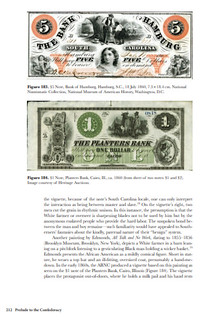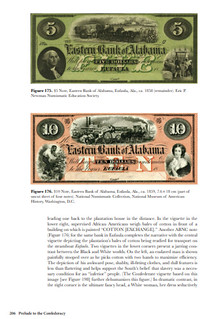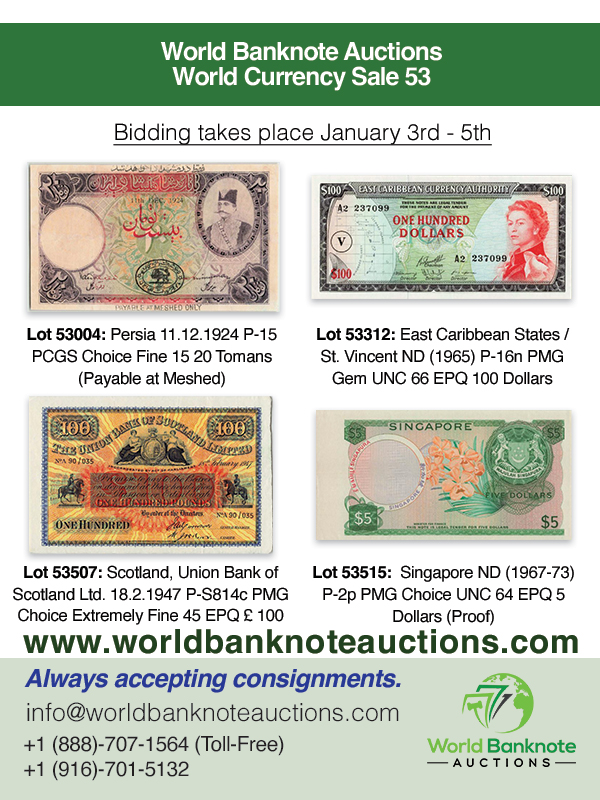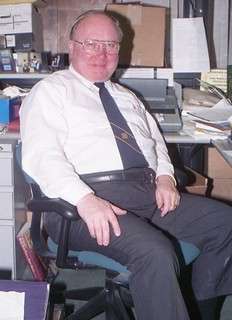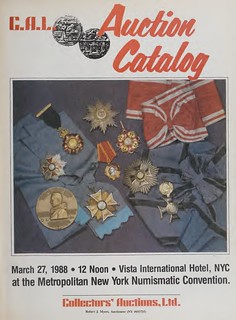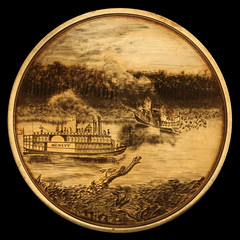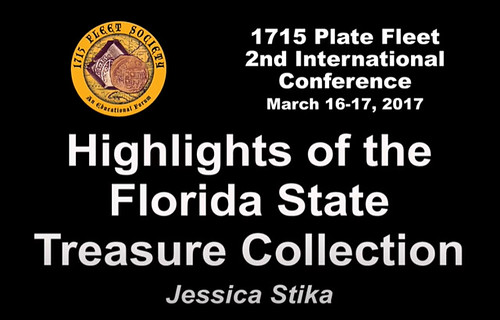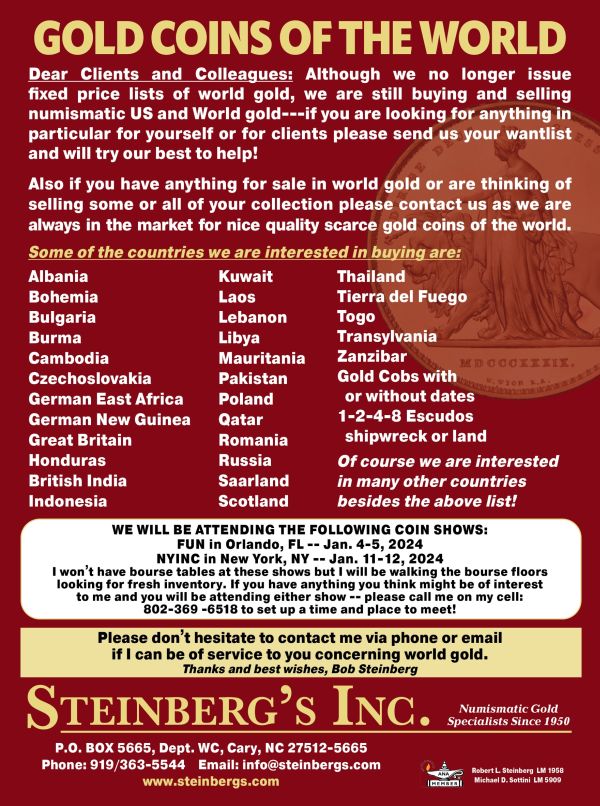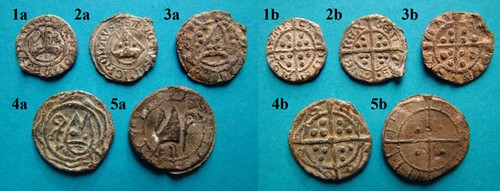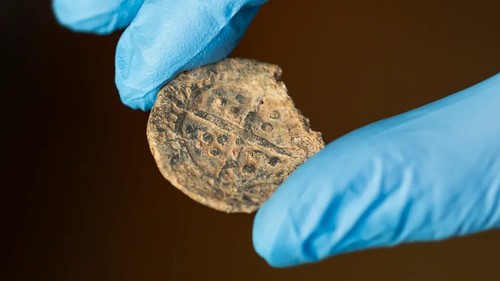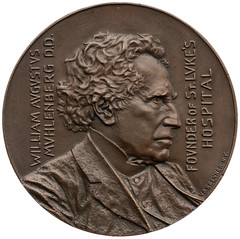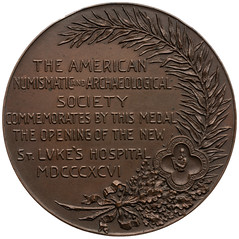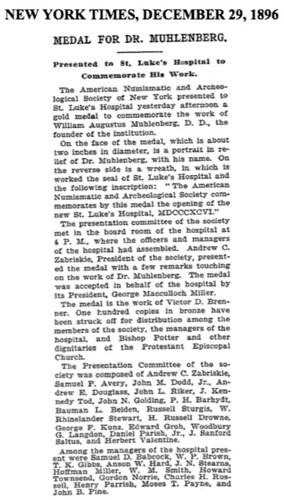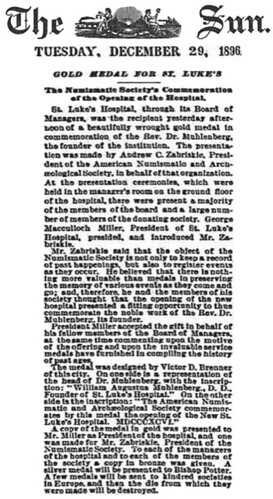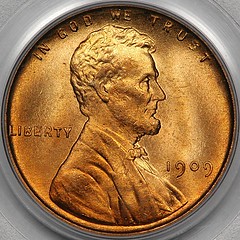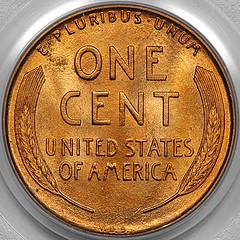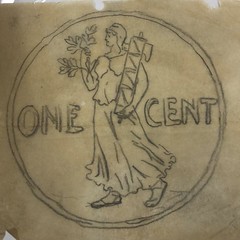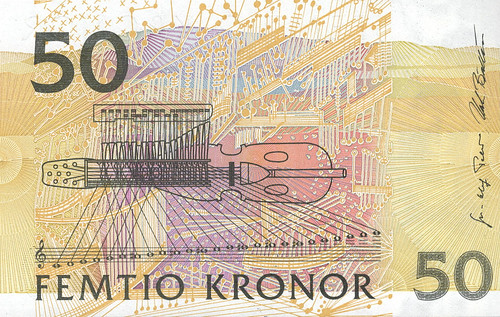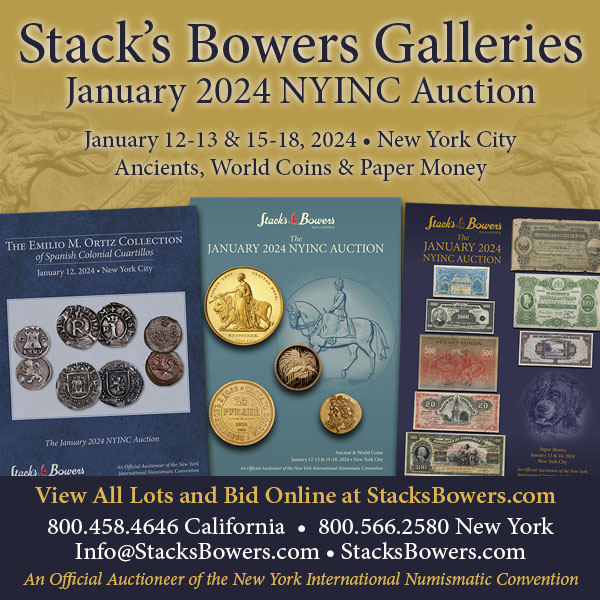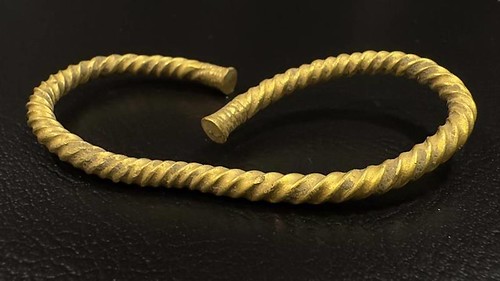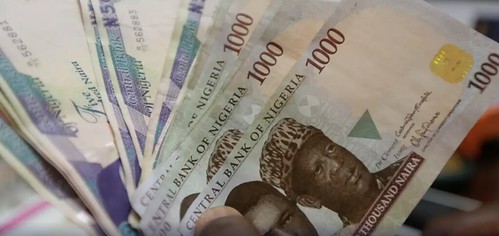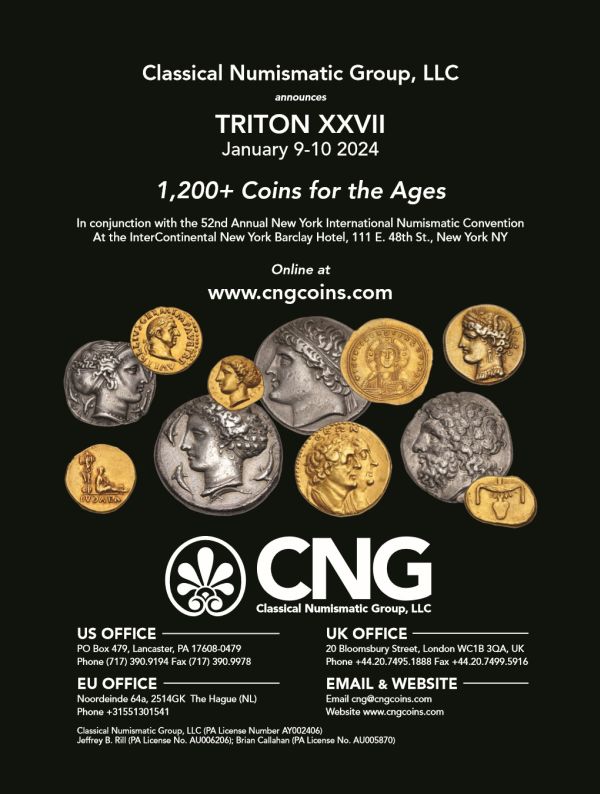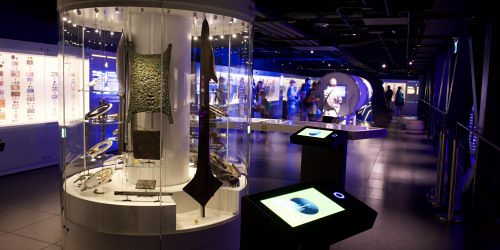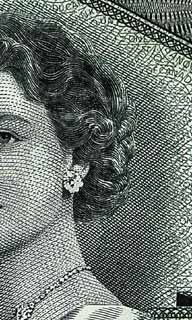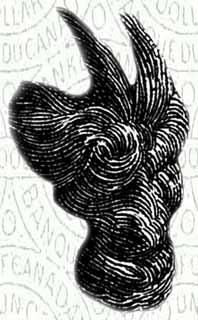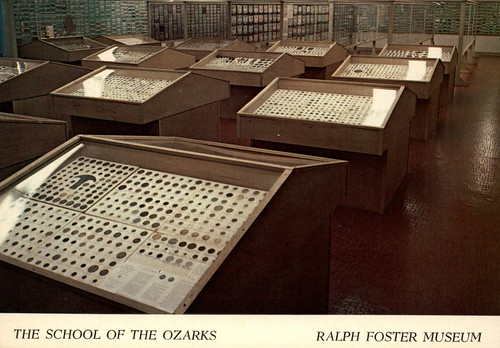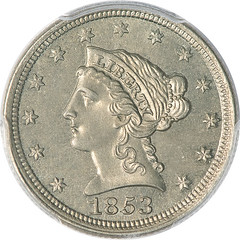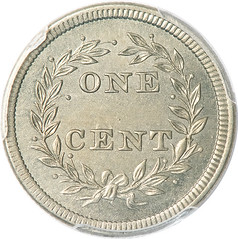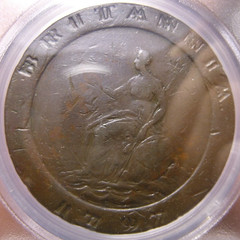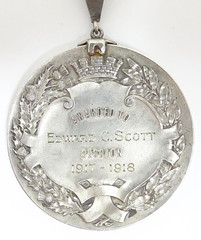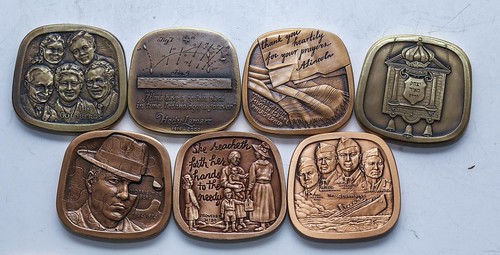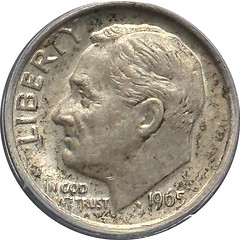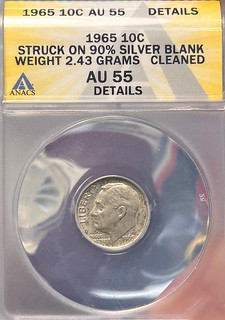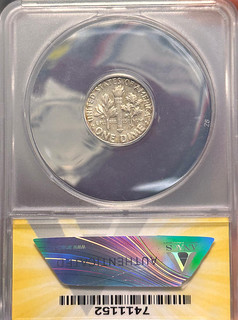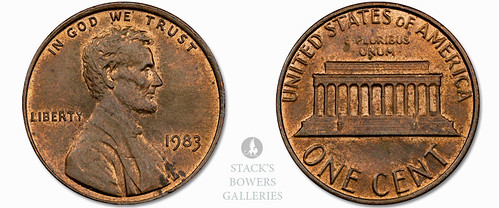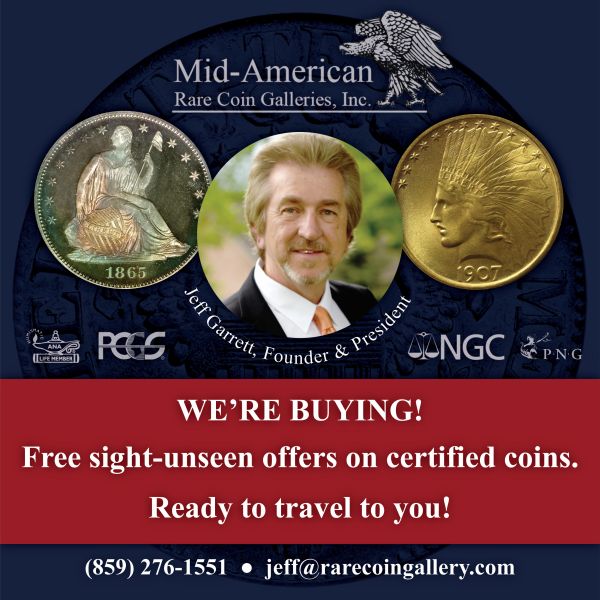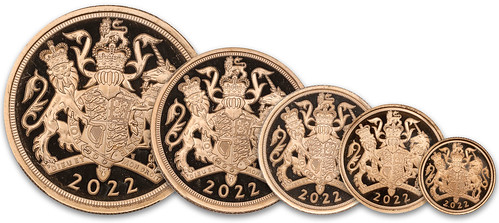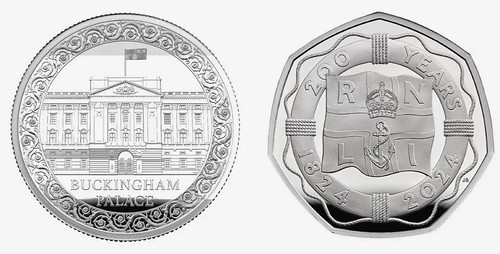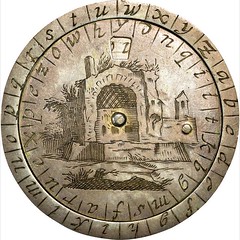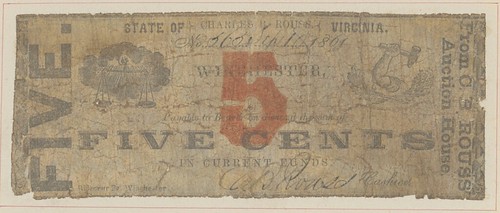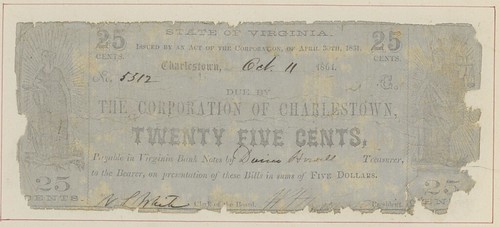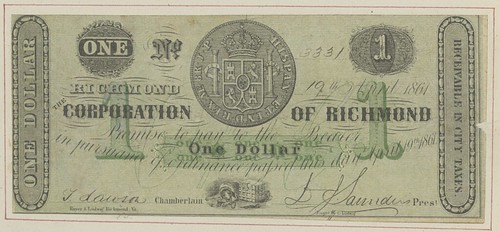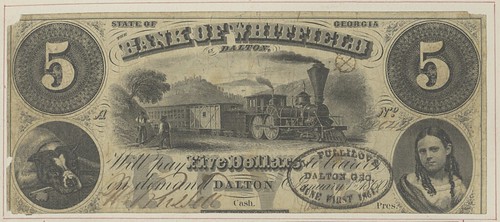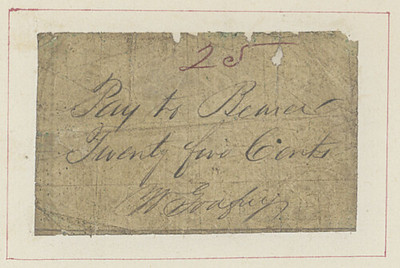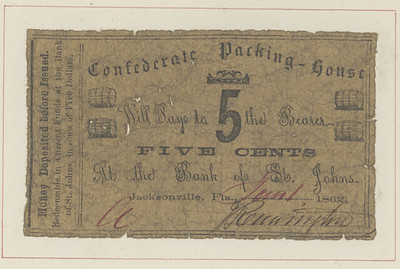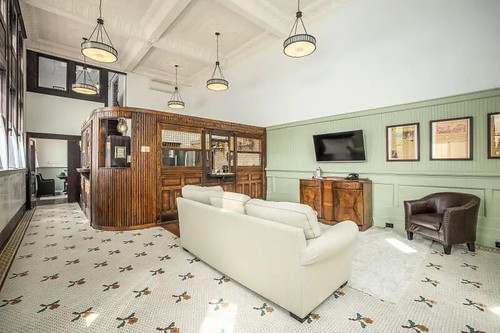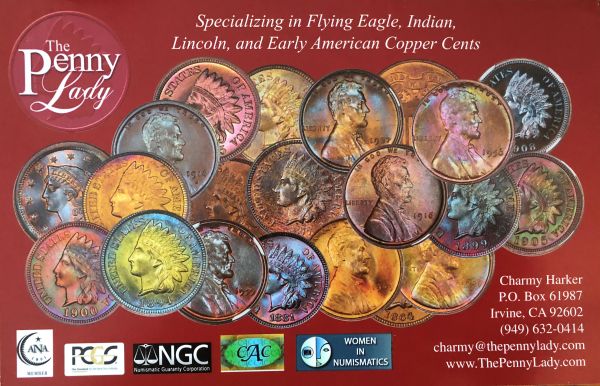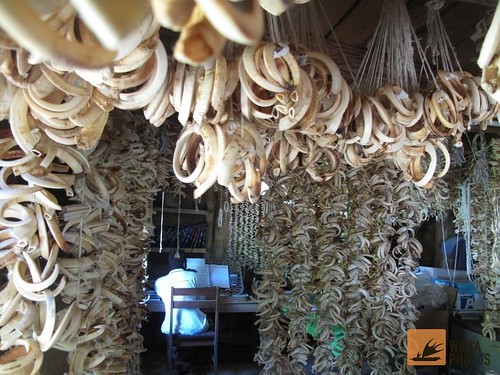
Visit our NBS Sponsors
About UsThe Numismatic Bibliomania Society is a non-profit association devoted to the study and enjoyment of numismatic literature. For more information please see our web site at coinbooks.org SubscriptionsThose wishing to become new E-Sylum subscribers (or wishing to Unsubscribe) can go to the following web page link MembershipThere is a membership application available on the web site Membership Application To join, print the application and return it with your check to the address printed on the application. Print/Digital membership is $40 to addresses in the U.S., and $60 elsewhere. A digital-only membership is available for $25. For those without web access, write to: Jeff Dickerson, Treasurer AsylumFor Asylum mailing address changes and other membership questions, contact Jeff at this email address: treasurer@coinbooks.org SubmissionsTo submit items for publication in The E-Sylum, write to the Editor at this address: whomren@gmail.com BUY THE BOOK BEFORE THE COINSale Calendar |
- WAYNE'S WORDS: THE E-SYLUM DECEMBER 31, 2023
- NEW BOOK: AMERICA'S PAPER MONEY
- JOHN B. LOVE (1936-2023)
- JOHN P. BURNHAM (1940-2023)
- NNP ADDS SMITH'S NUMISMATIC ROGUES GALLERY
- VIDEO: FLORIDA STATE TREASURE COLLECTION
- MORE ON BOY BISHOPS' CHURCH TOKENS
- REV. MUHLENBERG AND HIS MEDAL
- MORE ON JENNY LIND AND TAYLOR SWIFT
- NOTES FROM E-SYLUM READERS: DECEMBER 31, 2023
- REVIEW: BANK OF CANADA MUSEUM
- VOCABULARY TERMS: OVERSTRIKE, OVERSTRUCK
- JOHN PAUL BUTLER (1920-1982)
- NUMISMATIC RESEARCH REQUESTS SOUGHT
- TOM CALDWELL INTERVIEW, PART ONE
- WORLD BANKNOTE AUCTIONS: 2023 REVIEW
- NUMISMATIC NUGGETS: DECEMBER 31, 2023
- DATES ON ANCIENT COINS
- 1965 SILVER ROOSEVELT DIME FIND
- 1983 COPPER LINCOLN CENT
- STACK'S BOWERS OFFERS TRIAL OF THE PYX COINS
- 2024 ROYAL MINT COMMEMORATIVE COINS
- 18TH CENTURY GERMAN CYPHER WHEEL
- SOUTHERN STATES BANKNOTE ALBUM
- BARTLETT, TEXAS BANK RENOVATION
- PUZZLE PURISTS DECAMP TO A CASTLE
- LOOSE CHANGE: DECEMBER 31, 2023
- THE TANGBUNIA BANK OF VANUATU
Content presented in The E-Sylum is not necessarily researched or independently fact-checked, and views expressed do not necessarily represent those of the Numismatic Bibliomania Society.
WAYNE'S WORDS: THE E-SYLUM DECEMBER 31, 2023
 Thank you for reading The E-Sylum. If you enjoy it, please send me the email addresses of friends you think may enjoy it as well and I'll send them a subscription. Contact me at whomren@gmail.com anytime regarding your subscription, or questions, comments or suggestions about our content.
Thank you for reading The E-Sylum. If you enjoy it, please send me the email addresses of friends you think may enjoy it as well and I'll send them a subscription. Contact me at whomren@gmail.com anytime regarding your subscription, or questions, comments or suggestions about our content.
As noted earlier, this issue may arrive late because of the holiday. Happy New Year!
This week we open with two new books, two obituaries, updates from the Newman Numismatic Portal, notes from readers, and more.
Other topics this week include Numismatic Rogues, Boy Bishops, Rev. William Augustus Muhlenberg, Jenny Lind, the Bank of Canada Museum, dates on ancient coins, off-metal errors, the Trial of the Pyx, a bank building renovation, and the Tangbunia Bank of Vanuatu.
To learn more about America's paper money, the Florida State Treasure Collection, commemorative banknotes, tactile coin exhibits, the Ralph Foster Museum, Tom Caldwell of Northeast Numismatics, the rarity found in a Coinstar machine, the World's Richest Poor Man, and the World's Weirdest Bank, read on. Have a great week, everyone!
Wayne Homren
Editor, The E-Sylum
NEW BOOK: AMERICA'S PAPER MONEY
The Smithsonian Institution Scholarly Press has published a free 384-page electronic book by William L. Pressly called America's Paper Money: A Canvas for an Emerging Nation. Check it out - it's an important new look at the intersection of numismatics and art history.
Found via News & Notes from the Society of Paper Money Collectors (Volume IX, Number 28, December 26, 2023) -Editor
America's Paper Money: A Canvas for an Emerging Nation
William L. Pressly
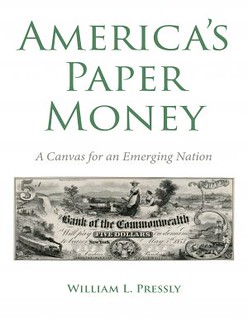 The Massachusetts Bay Colony in 1690 became the first government in the Western world to print paper money, the imagery for which initiated an indigenous American art form of remarkable dynamism and originality. After the Revolutionary War, disillusioned by how quickly its promiscuous printing of Continental currency had led to hyperinflation, the U.S. government left it to private institutions such as state-chartered banks to carry on this artistic American tradition. Adorned with a vast variety of images, bank notes soon became the fledgling country's primary currency. With pressures of the Civil War, the federal government in 1861 began taking charge of the paper-money supply by creating a national currency; simultaneously, the Confederate States of America was creating a competing self-image, making heavy use of bank-note vignettes. Later, collaboration between government engravers and well-known artists on the 1896 Silver Certificates marked the apex of U.S. government currency design. For two centuries, American creativity and technical ingenuity resulted in imagery on paper money that helped create and enhance the nation's imagined self.
The Massachusetts Bay Colony in 1690 became the first government in the Western world to print paper money, the imagery for which initiated an indigenous American art form of remarkable dynamism and originality. After the Revolutionary War, disillusioned by how quickly its promiscuous printing of Continental currency had led to hyperinflation, the U.S. government left it to private institutions such as state-chartered banks to carry on this artistic American tradition. Adorned with a vast variety of images, bank notes soon became the fledgling country's primary currency. With pressures of the Civil War, the federal government in 1861 began taking charge of the paper-money supply by creating a national currency; simultaneously, the Confederate States of America was creating a competing self-image, making heavy use of bank-note vignettes. Later, collaboration between government engravers and well-known artists on the 1896 Silver Certificates marked the apex of U.S. government currency design. For two centuries, American creativity and technical ingenuity resulted in imagery on paper money that helped create and enhance the nation's imagined self.
Publication Date: December 20, 2023
Availability: Electronically
Here's an excerpt from the book's Preface. -Editor
I have written this book to open a more fruitful dialogue between the disciplines of art history and numismatics as applied to American paper money. The numismatic literature has undertaken the Herculean task of documenting this extremely large body of material. Eric Newman's publications on Continental and Colonial currency are exemplary, and multiple catalogers have categorized the national currencies produced, beginning in 1861, by the federal government of the United States of America and by the Confederate States of America. Between these two eras, however, documenting the vast quantity of bank notes has proved to be a more daunting challenge. James A. Haxby made an impressive beginning, and Q. David Bowers is pursuing an even more thorough state-by-state catalog of bank notes and related currency. Other authors, such as Richard Doty, Bob McCabe, Mark D. Tomasko, and Heinz Tschachler, have provided helpful insights into issues involving the images used by banknote engravers, including the technology of bank-note production. In addition, digitization is transforming access to this vast material. Databases, such as the Newman Numismatic Portal at Washington University in St. Louis, are putting illustrations of paper money, along with the critical literature, at one's fingertips. All this research provides an indispensable foundation for further exploration.
One of the deficiencies of numismatic writers that this book hopes to correct is the lack of knowledge of the artistic context in which these works were created. Ignorance of academic art, with its long tradition of complex iconographies and its mixture of allegorical figures with historical ones, has sometimes led to the misidentification of a vignette's subject. The origins of whole genres of subject matter have at times escaped notice. Images of children performing adult tasks are not American drolleries, as some commentators would have it, but are taken from the conventions of rococo art. Some researchers of American paper money, such as John A. Muscalus, have been remarkably adept at locating old-master and contemporary sources for images appearing on currency, but they rarely go beyond the simple identification of a source to assess the significance of such borrowings or how the original design might have changed in its adaptation to this new context.
On the other side of the ledger, one might ask why so few art historians, with the notable exception of Jennifer Roberts, have held back from exploring in depth American paper money. One reason is the concern that notes, the product of commercial printing, are viewed as exemplars of skilled craftsmanship rather than as original works of art. In this regard, paper money is seen as falling more within the purview of visual culture than art history. This book offers arguments to the contrary. It attempts to open to art historians and the public an area of American art that has been largely overlooked and to encourage numismatists to see this material in new ways.
I began collecting American paper money when I was in the fifth grade, and I
often think this interest had an influence on my decision to become an art historian. Throughout my career, my area of study has been primarily eighteenth- and
nineteenth-century European art, but I am glad now to be able to give something
back to the field that first engaged my interest. While writing this book, my constant mantra has been ars longa, vita brevis
(art is long, life is short). This Latin
phrase, first coined by Hippocrates in Greek, is often misinterpreted to mean that
while one's life is fleeting, one's work will live on long after he or she has died. Instead, it means that one lifetime is too short a span in which to master an art. In
my case, this is all too painfully true, but I am delighted to have been able to make
a beginning.
To read the complete book, see:
America's Paper Money: A Canvas for an Emerging Nation
(https://scholarlypress.si.edu/store/all/americas-paper-money-a-canvas-for-an-emerging-nation/)
JOHN B. LOVE (1936-2023)
Silver dollar specialist John B. Love passed away on December 19th. He was born June 6, 1936. -Editor
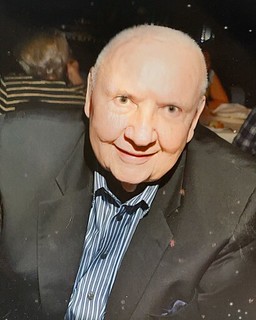 John Bracy Love, nationally known numismatist, went to meet his Lord on December 19, 2023. He was at his home in Whitefish, Montana surrounded by all his loved ones. In his last years, John was blind and had many health problems, but he stayed positive and strong, seldom complaining unless you interrupted his Grizzly game.
John Bracy Love, nationally known numismatist, went to meet his Lord on December 19, 2023. He was at his home in Whitefish, Montana surrounded by all his loved ones. In his last years, John was blind and had many health problems, but he stayed positive and strong, seldom complaining unless you interrupted his Grizzly game.
John was born to Virgil and Florence Bracy Love on June 6, 1936, in Carbondale, Illinois. As a small child the family moved to Burbank, California where Virgil went to work for Columbia movie studios. John graduated from John Burroughs High School in Burbank, and then went to Los Angeles Valley Junior College on a football scholarship. His team was successful, and they went on to win the championship for their football league in 1955. After graduating, John was offered a football scholarship to the University of Montana. While at the U of M, John met his wife of 63 years, Karla Kay Kluth. The couple were married in 1960. Shortly after they married, they moved to Cut Bank, MT where John managed the Orpheum Theater Company for his mother-in-law. They lived in Cut Bank for over 50 years and raised their daughter, Lisette Lee Love, and son, John Byron Love, there.
During the time John worked at the theater, silver was the currency people used and he soon got interested in silver dollars. That was the beginning of his career in the coin business. He started Record Coin in 1962. At the same time, he hired Diane Biegler as his secretary and she is still there today. Throughout his career he was a member of the Professional Numismatists Guild (PNG), a lifetime member of the American Numismatic Association (ANA), honored with the National Silver Dollar Roundtable Lifetime Achievement award in 1990, and inducted into the Professional Coin Grading Services (PCGS) Coin Dealer Hall of Fame in 2011. He loved to go to work and was still working up until the time of his death. In addition to his coin business, he and Roy Roper of Twin Falls, Idaho, along with Theo Bartschi and Byron Kluth started Interstate Amusement in 1967 in Twin Falls, which grew to 25 movie screens. They sold the theaters in 2014.
John loved animals, horses in particular, and soon he started running racehorses. His horse trainer was Tommy Roberts, and they raced up and down the West coast, using jockeys such as Gary Stevens, Johnny Longden, and Will Shoemaker. In the 1980's, John was the leading owner in races won in the nation. He also had a horse named Blue Rimrock, which was voted best claiming horse nationwide in 1985.
To read the complete obituary, see:
John Love
(https://www.asperfh.com/obituaries/john-love)
Here's some additional information from CoinWeek. -Editor
Love, along with fellow Morgan dollar specialist Wayne Miller, is widely regarded as one of the pioneers of the modern silver dollar market. The two were partners for a short time in the early 2000s.
When the Redfield Hoard of Morgan dollars came to market, John was one of its three major distributors. He handled Morgan dollars by the bag, by the roll, and by the coin. Love was a mentor to PCGS and NGC coin grader Michael Miles
Standish and is listed as a contributor to Standish's book Morgan Dollars: America's Love Affair with a Legendary Coin.
To read the complete article, see:
Legendary Coin Dealer John B. Love Has Passed Away
(https://coinweek.com/legendary-coin-dealer-john-b-love-has-passed-away/)
JOHN P. BURNHAM (1940-2023)
George Cuhaj and Tony Terranova alerted me to the passing of John P. Burnham on December 16th. -Editor
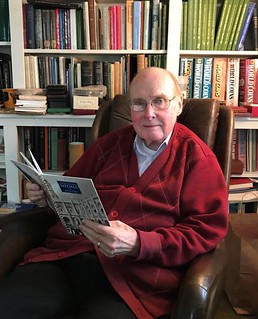 Born to George R. Burnham and Kaarin (Maki) Burnham, John began his life of uncommon learning and accomplishment on July 20, 1940 in Portland, Oregon. There, with his beloved parents and sister Kaarin (Burnham) Cargill, John spent near every weekend of his childhood exploring the Columbia River Gorge and the numerous parks along the old highway - picnicking at Wahkeena Falls, tromping through the forest, intrepidly leading adventures up Oneonta Gorge, a lifelong favorite. Innumerable family road trips to Wecoma Beach and San Francisco further fueled the travel and exploration bugs. Those formative years were also the beginning of John's lifelong passions for trains and for coins and collecting (his first coin, a gift from his mother, a 1912 Liberty Head dime from the Denver Mint).
Born to George R. Burnham and Kaarin (Maki) Burnham, John began his life of uncommon learning and accomplishment on July 20, 1940 in Portland, Oregon. There, with his beloved parents and sister Kaarin (Burnham) Cargill, John spent near every weekend of his childhood exploring the Columbia River Gorge and the numerous parks along the old highway - picnicking at Wahkeena Falls, tromping through the forest, intrepidly leading adventures up Oneonta Gorge, a lifelong favorite. Innumerable family road trips to Wecoma Beach and San Francisco further fueled the travel and exploration bugs. Those formative years were also the beginning of John's lifelong passions for trains and for coins and collecting (his first coin, a gift from his mother, a 1912 Liberty Head dime from the Denver Mint).
After graduating, as valedictorian, from Jefferson High in 1958, John attended the University of Oregon where he starred for the University's College Bowl team before graduating Phi Beta Kappa. John then left his beloved Oregon to attend graduate school at Yale University in New Haven, Connecticut. Connecticut would become his home for the ensuing six decades. After earning his degree (in part paid for by his winnings playing Gin) John joined the faculty at Connecticut College as a professor of economics. At Connecticut College, he met Christina, the love of his life. The couple married in 1967 and would raise four sons together, primarily in their book-filled (oh so very, very book-filled!) and historic home in Old Saybrook.
In addition to teaching at Connecticut College John gave his considerable efforts and talents to many other roles: he served on the Governor's Council of Economic Advisors of Connecticut; was Curator of the Yale Numismatic Collection for 30+ years; a numismatic consultant to Stack's/ Coin Galleries in New York; a financial consultant and columnist; director of the Connecticut Central Railroad; President of the Valley Railroad; on the Board of Directors of the Providence and Worcester Railroad; a fellow of the American Numismatic Society and founding member of its Augustus B. Sage Society; chairman of the Waterford, CT Board of Finance; and many more too numerous to list, though he undoubtedly would have liked them to be.
His curious nature always meant there were new and more books being added to the collection, books on near any subject one could imagine (This Was Logging anybody?). Luckily, the many visits to bookstores, be it Powell's in Portland (on summer trips out west) or the Yale Co-Op, meant a new book for each son to pick out as well. Time was always made in his busy schedule to support his sons...
John's intellectual curiosity was reflected in his hobbies, of which there were a great many. He loved collecting coins; reading (always a pile of books in various progress); collecting medals; playing chess; collecting paper money; playing cards (gin, cribbage, pinochle); collecting railroadiana; ensuring his children had strong cardio by making them sprint through the labyrinthian New York subway system or risk being left behind; collecting political memorabilia; crosswords; collecting books; dining with friends and family; and, it can't be stressed enough; collecting.
His entry in the 2009 An Island of Civility: The Centennial History of the New York Numismatic Club reads as follows. George Cuhaj supplied the photo of John at his Coin Galleries cube in the early 1990s. -Editor
John P. Burnham. Member: 1992-Present
Educated at the University of Oregon and at Yale. Cataloguer for Stack's. Part-time curator of the Yale numismatic collection for nearly thirty years. An avid collector of medals, he led one of the first medals-only auction houses, Collectors Auctions Ltd. He is a member of the ANA, the Russian Numismatic Society, the Medal Collectors of America, Phi Beta Kappa, Delta Chi, the Elizabethan Club and the Mory's Association. He is the former chairman of the Connecticut Central Railroad and the Valley Railroad Company, and served on the board of directors of the Providence and Worcester Railroad Company and the Mutual Shares Corp.
The entry for Collectors Auctions Ltd of Danbury, CT in Martin Gengerke's 2009 American Numismatic Auctions lists sales dated 9/13/1987 through 5/4/1991. -Editor
Catalog numbers are continued from the Johnson & Jensen series.
After sale number 35 the firm moved to Old Saybrook, CT, and the next catalog was number 8, reflecting the desire of the owner to separate the firm from the Johnson & Jensen catalogs. The Newman Numismatic Portal includes Collectors Auctions as a continuation of the Johnson & Jensen series.
Alan V. Weinberg writes:
"I knew John fairly well when he worked upstairs for Stack's on 57th Street. A quiet and seemingly humble, soft-spoken man, I'd heard he was well connected and accomplished but I had no idea just how prominent he was. He never portrayed himself as being so accomplished.
"I have at least two unique medals in my collection acquired privately from John, after much pleading. One a hand tooled silver 1835 American shooting award, and one a large high quality gold, originally cased, 1840's completely hand engraved life saving medal from Alabama depicting a paddle wheel afire and sinking.Acquired perhaps 30 yrs ago from John at a very firm non-negotiable $10K. Very high then but I had to have it. John would not have sold it but for my intense interest."
Great medal! Amazing work. Thanks, everyone. -Editor
To read the complete obituary, see:
John Printz Burnham
(https://www.dignitymemorial.com/obituaries/old-saybrook-ct/john-burnham-11588383)
THE BOOK BAZARRE
NNP ADDS SMITH'S NUMISMATIC ROGUES GALLERY
The latest addition to the Newman Numismatic Portal is Pete Smith's Numismatic Rogues Gallery. Project Coordinator Len Augsburger provided the following report. -Editor
Pete Smith's Numismatic Rogues Gallery Added to NNP
The commercial side of numismatics has a way of attracting ne'er-do-wells, and to be sure academic and museum collections are no less susceptible. Pete Smith's latest work shines a spotlight on 275 perpetrators of numismatic crimes, compiling the pertinent data in a single reference. In earlier days, dealers published their own lists of individuals not to be trusted, but the explosion of public information in the Internet age allows for a more systematic approach.
Readers are encouraged to contribute suggestions and additions.
Image: Samuel Hudson & Henry Chapman frauds
list
Note that Pete's book isn't a list of deadbeats who don't pay their bills - a documented conviction is required. Handy categories include burglary, counterfeiting, drug trafficking, embezzlement, bank fraud, mail fraud, money laundering, murder, pedophilia, Ponzi schemes, fencing stolen property, safe cracking, tax evasion and plain old theft, with special chapters for the Dupont and Fogg Museum heists. Bank safes, FBI raids, cash hoards, dead bodies, mug shots and prison jumpsuits abound. But it's not just rogues - their victims appear here, too. Interesting reading. -Editor
Link to Numismatic Rogues Gallery on NNP:
https://nnp.wustl.edu/library/book/634354
Link to S. H. & H. Chapman 1906 client list, including frauds
:
https://nnp.wustl.edu/library/archivedetail/516023
VIDEO: FLORIDA STATE TREASURE COLLECTION
The David Lisot Video Library on the Newman Numismatic Portal can be found at:
https://nnp.wustl.edu/library/multimediadetail/522852
We highlight one of his videos each week in The E-Sylum. Here's one from the 1715 Fleet Society Conference in 2017 about the Florida State Treasure Collection. -Editor
Highlights of the Florida State Treasure Collection
The state of Florida has an extensive collection of artifacts from the countless shipwrecks that have gone down along its coast. See examples of many of the items as well as conservation techniques used to preserve them. Speaker: Jessica Stika. Running time: 44:17.
To watch the complete video, see:
https://nnp.wustl.edu/library/book/540278
MORE ON BOY BISHOPS' CHURCH TOKENS
David Powell kindly provided this information on the medieval Boy Bishops and their Christmas tokens. Thank you! -Editor
 There is an excellent paperback on the history of the Boy Bishop tradition in the form of Neil MacKenzie's
There is an excellent paperback on the history of the Boy Bishop tradition in the form of Neil MacKenzie's The Medieval Boy Bishops
.
I have written a couple of pages on the subject in my lead token newsletter at LTT_128, pages 2-3 {see https://thetokensociety.org.uk/ltt/ }, and there are various examples illustrated elsewhere throughout the Leaden Tokens Telegraph {see specifically the display on the back page of LTT_88}, but Gary Oddie knows a lot more about the things than I do.
The Boy Bishop token coinage of East Anglia more closely approximates to regal money than any other lead issue, particularly in the early days c.1485-1500 when it was at its finest, and our main purpose, of course, is to ascertain just what role it fulfilled. Was it ceremonial money only, or was it used in lieu of real money and subsequently exchanged like, for example, pickers' checks?
Perhaps the use of token coinage, rather than real money, was part of that control; having said which, we have no firm evidence for it having been deployed generally, beyond the area of East Anglia for which it is known. Not to say that it wasn't, of course; maybe some of the other known ecclesiastical lead and pewter tokens fulfilled the same role without us realising it. However, it is very possible that the use of tokens was local only to certain cathedrals' traditions.
As regarding a catalogue, the 1984 article by Mitchiner and Skinner in BNJ54, pages 86-163 {see https://www.britnumsoc.org/publicns/bnj-articles-by-year } is the best I know to date; in terms of their type classification, Boy Bishops are types P and R. However, as with most lead, of the late mediaeval and early modern period, new types are being dug up all the time.
Gary Oddie writes:
"For the so-called Boy Bishop tokens - Daniel Haigh was the first to speculate that the lead tokens with bishop's mitres etc might have been used as part of the feast of St Nicholas (Num Chron, 1843, pp 82-90). The first, and so far only, catalogue of the type was written by Stuart Rigold (Proceedings of the Suffolk Institute of Archaeology and History. 34(2) pp87-101. 1978, with a couple of later supplements). Michael Mitchiner's catalogues derive from these.
"There is no documentary evidence for the use of the tokens during the feast of St Nicholas and they were more likely issued by the larger religious establishments as alms or small change. Indeed the cult of St Nicholas was commonplace across Northern Europe and all of England (T. Skambraks; Das Kinderbischofsfest im Mittelalter, 2014), whereas the tokens that fit this type are exclusive to East Angla. When I last looked, the Portable Antiquities Scheme had listed over 500 "Boy Bishop" tokens from East Anglia along with 20 or so outside this area that are all misidentifications.
"Rigold's listing can now be extended to include lead halfpennies and some much larger pieces as well as several new legend types and portrait pieces."
Very interesting! Thanks, everyone. -Editor
To read the earlier E-Sylum article, see:
MEDIEVAL CHURCH CHRISTMAS TOKEN FOUND
(https://www.coinbooks.org/v26/esylum_v26n52a22.html)
REV. MUHLENBERG AND HIS MEDAL
Author Jim Haas submitted these notes on Rev. William Augustus Muhlenberg and the medal Victor David Brenner designed featuring him. Thanks! -Editor
My current project of editing a book penned by an artist friend is coming to an end, and my hope is to begin writing another book. The subject will be either a comprehensive history of College Point, NY or how the community experienced WWII. Both are near and dear.
With regard to the former, yesterday I chanced upon two versions of an article about a new medal that was published in the New York Times and The Sun in 1896. The person for whom the medal was struck, Rev. William Augustus Muhlenberg, also gave College Point its name. Here's the story.
In late summer 1835, Rev. Muhlenberg, great-grandson of the founder of the Lutheran Church in America, purchased a tract of land of about one hundred acres in the township due north of Flushing in Queens, NY, the location commonly called Strattonport. Using his own financial resources and those of a few other equally disposed individuals, his plan was to erect a college there to educate young men for ministry in the Episcopal church. Scheduled to open its doors in 1837, the financial panic that was crippling both the nation and his investors put the project in jeopardy. A much diminished version of the college named for St. Paul, was opened in 1837, but never truly got off the ground. The site on which St. Paul's College was erected came to be called College Point.
Muhlenberg went on to spend the majority of his eighty years in ministerial service. During the Civil War years he played a significant role in the building of a hospital in New York City to care for the wounded streaming back from the various theaters of the war. The hospital named for St. Luke, patron of physicians, is still in operation today.
As I'm sure you know, the medal was the work of Victor David Brenner. One hundred bronze copies of the medal were struck for distribution to society members, hospital managers, Bishop Potter and other dignitaries of the Protestant-Episcopal Church. A gold medal was presented to George MacCulloch Miller, president of the hospital and another for Andrew C. Zabriskie, President of the Numismatic and Archaeological Society. Throughout his life Zabriskie, 1853-1916, was a collector of coins and medals, having one of the best collections in the country that included many rare Lincoln medals. He was president of the Society for ten years.
The ANS archives contain a scrapbook of Zabriskie's, with more information on the cornerstone laying ceremonies, as well as the members of the Joint Committee on the Improvement of the United States Coinage. Who can tell us more about that body? -Editor
Jim adds:
"Taking a look at the medal it occurred to me to wonder if like MacNeil, who reworked previously used medal designs, did not Brenner harken back to this effort when pondering the Lincoln penny. They are remarkably similar design-wise."
Well, there are some similarities. Of course, the closest predecessors for the obverse were Brenner's Lincoln plaque designs. At Jim's suggestion I reached out to Shawn Tew, author of The Rabbit Hole of the 1909 Wheat Cent. -Editor
Shawn writes:
"In my research with the archives the current Brenner design of the Lincoln Cent was in fact the third one submitted and it was due to the suggestion of President Taft of a Brenner statue in the White House. Here are the first two sketches submitted for approval. But Brenner being an experienced medalist, he designed all of his medals with the same type of elements in similar arrangements which caused issues when it went to produce the smaller scale coinage."
Jim adds:
"The 3rd design is a gigantic leap from the first two sketches. From whence the dramatic change? The left-facing walking figure reminds me of the front-facing St. Gaudens.
"Acknowledged that the Lincoln profile is not the Muhlenberg and the verbiage is not centered on the coin, but the presence of the acanthus frond or maybe wheat sheaf on the right side could have easily been his inspiration for the two sheaves of wheat enclosing the reverse on the Lincoln penny."
For more information on the medal, see:
Bronze Medal of American Numismatic Society, New York City. 0000.999.6717
(http://numismatics.org/collection/0000.999.6717)
Medallic Art of the American Numismatic Society, 1865–2014
(http://numismatics.org/digitallibrary/ark:/53695/Miller-ANS-Medals)
For more information on the Zabriskie scrapbook, see:
Andrew C. Zabriskie scrapbook, 1893-1894
(http://numismatics.org/archives/ark:/53695/nnan0127)
To read the earlier E-Sylum article, see:
THE RABBIT HOLE OF THE 1909 WHEAT CENT
(https://www.coinbooks.org/v26/esylum_v26n30a10.html)
NEW BOOK: THE 1909 LINCOLN WHEAT CENT
(https://www.coinbooks.org/v26/esylum_v26n33a04.html)
MORE ON JENNY LIND AND TAYLOR SWIFT
Roland Rollins writes:
"One cannot forget the Swedish 50 Kroner banknote produced from 1996-2003. I started both of my kids collecting world banknotes three decades ago. The bug stuck with my son, who collects all countries "dead" or current. My daughter collects only banknotes related to music, so the note below resides in her collection. There is more than just her image:
"Front: Musical notes from Vincenzo Bellini's opera "Norma, singer Jenny Lind, roses, Carl Fredrik Adelcranz's drawing of Stockholm's old opera house, microprinted quote from composer Arnold Schoenberg.
"Back: Silver harp and it's tonal range, excerpt from the score "Pictures of Percussion and Orchestra" .
"The watermark is also a Jenny Lind pattern."
Thanks - nice note! -Editor
"I'm consulting, gratis, for Royal Joh. Enschede in the Netherlands. My concept is to utilize banknote design, in limited editions, to help artists, athletes and charities raise funds. With my concept, banknotes could raise millions for charities for a low cost. I also imagine helping the collectors of commemorative banknotes at the same time.
"Taylor Swift helps animal shelters for cat & dog rescues. Here's a draft of a portrait we are working on for a commemorative banknote. We are still trying to get a license. It was done by banknote artist Tom Stebbins for my Banknotables collection. Hopefully Taylor or one of her Swifties gets to understand the concept."
Commemorative banknotes are a fine idea. There's a huge surplus of non-circulating collectible coins and medals - why not more banknotes? It's such a long, involved process to create official government banknotes that they often don't change for years or even decades. A commemorative banknote market would allow artisans in the industry to create nice work that would actually see the light of day. -Editor
To visit Bob's Banknotables site, see:
http://www.banknotables.com/
For more on Royal Joh. Enschedé's Collectible Banknotes, see:
A real world asset in the form of an exclusive banknote
(https://theglobalnote.com/)
New Collectible Banknote and Augmented Reality Experience Honoring Football Legend Dennis Bergkamp
(https://www.joh-enschede.nl/2023/12/14/new-collectible-banknote-and-augmentedreality-experience-honoring-football-legend-dennis-bergkamp/)
To read the earlier E-Sylum articles, see:
TAYLOR SWIFT AND NUMISMATICS
(https://www.coinbooks.org/v26/esylum_v26n47a12.html)
NOTES FROM E-SYLUM READERS: NOVEMBER 26, 2023 :
Taylor Swift and Jenny Lind
(https://www.coinbooks.org/v26/esylum_v26n48a15.html)
JENNY LIND AND SWIFT-MANIA
(https://www.coinbooks.org/v26/esylum_v26n52a30.html)
NOTES FROM E-SYLUM READERS: DECEMBER 31, 2023
More on Rex Stark
Donald Ackerman writes:
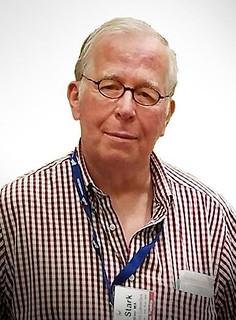 "When you reach a certain age, friends and colleagues start dying off which can be rather depressing but, as they, say, it beats the alternative!
"When you reach a certain age, friends and colleagues start dying off which can be rather depressing but, as they, say, it beats the alternative!
"I first met Rex around 1976. While at a show, he showed me a bunch of snapshots of items in his collection.
"In remembering Rex, I can't think of a single bad thing to say about him. He was truly a straight shooter who treated everyone with respect and courtesy. He did have a rather sardonic, dry sense of humor which shone through on occasions.
"He was entrusted with the sale of Richard Ulbrich's Indian Peace Medals and George Washington Inaugural Buttons, having established a trusted position with the family.
"Buying and selling collectibles was Rex's life blood. He loved the action of setting up at shows and bidding at auctions. Not too many items escaped his radar. After receiving his cancer diagnosis, Rex could have opted to spend his last days traveling and checking off items on his bucket list. But, he didn't have a bucket list. He did not change his routine. Some years back, Rex bought Patti a house in Tasmania and she implored him to move to Australia, but he would have none of it (he didn't want to cross paths with 12 Huntsman spiders or other poisonous denizens of the outback). Outside of yearly trips to London for the Ceramic Fair, he stayed in New England, convenient to Brimfield and Antiques Week in New Hampshire, as well as other hobby events. He wasn't consumed by his illness (at least not emotionally or intellectually). He did what he loved best until the very end."
Thanks. Might as well go out with one's boots on! -Editor
To read the earlier E-Sylum article, see:
REXFORD ADDISON STARK (1947-2023)
(https://www.coinbooks.org/v26/esylum_v26n52a06.html)
More on Michael Kirzner
In response to Mike Bourne's question,
Julian Leidman writes:
"Michael Kirzner was not an obscure dealer back in the early 70's. He was a well known dealer at shows. I had many dealings with him, although I could not name anything specific. He was very knowledgeable and I remember that he offered to pay $1,000 for a real uncirculated Bust Dollar, which I had never seen at the time."
Alan V. Weinberg writes:
"Michael Kirzner of the Boston area was a
prominent, self-employed professional numismatist back in the 1970's who handled rare coins far above the level of most dealers. I knew him fairly well. At the time he was in his late 20s-early 30's & was considered a wunderkind
along with Jim Halperin, Steve Ivy and a very young Kevin Lipton.
"Unfortunately Mike got sucked into handling stolen coins from organized crime burglary / robbery gangs, testified against them and became a convicted / protected witness
, secluded for years.
"About a decade ago I wandered into a fancy antique shop and immediately recognized the store owner as Mike Kirzner, still looking very much like his self of the 1970's but older & still handsome. He'd aged well. We talked briefly and I got the feeling that he was still conscious of being sought after by crime figures he helped convict. Mike would be in his late 60's-early 70's now but looks younger.
"I'm reliably informed that a Kirzner-contemporary wunderkind
Alan Brotman, once a friend of Kirzner, also once involved in numismatic criminal activity during a prominent career and not seen for many years in the hobby, was present and wandering on the Pittsburgh ANA bourse floor last August."
Julian adds:
"Kirzner was much older than the wunderkids that Alan referred to, 10-15 years older. I have seen Brotman several times at shows over the past couple of years."
Thanks, everyone. Sad stories. Brotman's brushes with the law are documented in Pete Smith's new Numismatic Rogues Gallery, discussed elsewhere in this issue. -Editor
To read the earlier E-Sylum article, see:
NOTES FROM E-SYLUM READERS: DECEMBER 24, 2023 : Michael Kirzner Information Sought
(https://www.coinbooks.org/v26/esylum_v26n52a13.html)
More On Encapsulation and Coin Weight
Ralf Böpple of Stuttgart, Germany writes:
"When wondering about the pros and cons of encapsulated coins, it is, in my opinion, always helpful to start with where this idea originally came from: US coins. There was a need to weed out numismatic forgeries, and, more importantly, there was a need to establish whether a coin was "MS-64" or "MS-65", since this separated the market for uncirculated coins into several ones and enhanced the profits for the industry.
"While US coinage is very uniform in weight and quality of strike, and there usually is no need for recording the weight, the same does not hold true for most coins from Latin America, and even less so if they were used to create necessity coinage. So many of the rules and reasons for slabbing US coins do not really work for them. Or even work against them, as in this case, where it is no longer possible to properly study the coin.
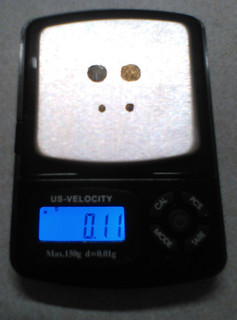 "If I were to win the lot in question in the upcoming auction at a price I consider reasonable (unlikely given the current markets, but one never knows), I would take this coin out of its "Snow White's coffin", as I like to call these slabs. From a numismatic point of view, there is no reason for this coin to be in one. The coin would then enter my collection database with its correct weight and dimensions."
"If I were to win the lot in question in the upcoming auction at a price I consider reasonable (unlikely given the current markets, but one never knows), I would take this coin out of its "Snow White's coffin", as I like to call these slabs. From a numismatic point of view, there is no reason for this coin to be in one. The coin would then enter my collection database with its correct weight and dimensions."
While the owner of a coin can of course remove and weigh it, researchers working from grading company and auction house records are at a loss if the weight is never published. But we're spoiled by the existence of online information and miffed when it's not as complete as we'd like - as in the past, only one with physical possession of the coin is in a position to measure and record its weight. -Editor
To read the earlier E-Sylum article, see:
NOTES FROM E-SYLUM READERS: DECEMBER 24, 2023 : Coin Weight as Proprietary Information
(https://www.coinbooks.org/v26/esylum_v26n52a13.html)
Morgan Bulkeley Information Sought
Gary Greenbaum writes:
 "In addition to being a retired lawyer, I improve Wikipedia articles. Recently I've been working on that of Morgan Bulkeley. In addition to being a senator from Connecticut and governor, he was the first president of baseball's National League, for just under a year, for which he's been enshrined in Cooperstown's National Baseball Hall of Fame, though whether he should have been placed there in the first place is somewhat open to question.
"In addition to being a retired lawyer, I improve Wikipedia articles. Recently I've been working on that of Morgan Bulkeley. In addition to being a senator from Connecticut and governor, he was the first president of baseball's National League, for just under a year, for which he's been enshrined in Cooperstown's National Baseball Hall of Fame, though whether he should have been placed there in the first place is somewhat open to question.
"After completing the research I needed, I somewhat as a lark checked The Numismatist's archives. Somewhat to my surprise, I found him in the February 1918 issue (p. 75), one of 96 donors who had contributed just under 20,000 items to the American Numismatic Society. His name appears among such numismatic and non-numismatic figures as J. Pierpont Morgan and Farran Zerbe.
"None of the biographical sources I've read on Bulkeley mention any interest in coin collecting, and the few results from the Newman Portal don't help. Bulkeley was a bank president in the 1870s before becoming the long time president of Aetna and he may have accumulated unusual coins at some time or other. Any connection between a member of the Baseball Hall of Fame and numismatics is also interesting.
"Does anyone know anything that can expand on this enigmatic reference?"
Interesting. I'm not familiar with Bulkeley. Can anyone help flesh out his numismatic side? -Editor
To read the Wikipedia article, see:
Morgan Bulkeley
(https://en.wikipedia.org/wiki/Morgan_Bulkeley)
Gold Bracelet Found in Norway
Paul Horner writes:
"A neat find of a gold bracelet in Norway."
To read the earlier E-Sylum article, see:
Metal detectorist stumbles on very rare gold treasure from 2,500 years ago, photos show
(https://www.miamiherald.com/news/nation-world/world/article283524498.html)
Video: Nigeria's Fake Banknotes
Howard Berlin passed along this video about how Nigeria is dealing with fake bank notes. Thanks. -Editor
Fake naira bank notes are in circulation in Nigeria, and the country's central bank has warned the public to stay vigilant. But authorities are doing little to confront the problem, leaving it mostly up to locals to work out if the money they're exchanging is real. As a result, trust in Nigerian currency is being undermined. DW's Flip Side takes a look.
To watch the video, see:
How is Nigeria dealing with fake bank notes?
(https://www.dw.com/en/how-is-nigeria-dealing-with-fake-bank-notes/video-67834246)
REVIEW: BANK OF CANADA MUSEUM
Tom Babinszki publishes the Blind Coin Collector blog. In July he spoke about tactile coin exhibits at a conference, and this month he followed up with a review of accessible coin exhibits at the Bank of Canada Museum. With permission, we're republishing his two posts here. -Editor
Tactile coin exhibits
 Last month I attended the Leadership Exchange in Disability and the Arts conference in Boston. I was very interested in the conference, so when I decided to attend, I thought it would be great to contribute something interesting. Given that not too many accessible and tactile coin exhibits exist, I submitted a short proposal about how to make coin exhibits accessible for blind people.
Last month I attended the Leadership Exchange in Disability and the Arts conference in Boston. I was very interested in the conference, so when I decided to attend, I thought it would be great to contribute something interesting. Given that not too many accessible and tactile coin exhibits exist, I submitted a short proposal about how to make coin exhibits accessible for blind people.
It was accepted. I didn't think much of it at the time, I thought it would be an interesting concept, but let's face it, coin collecting is not a common hobby among blind people. Thus, coin museums are generally as inaccessible as could be for anybody who needs a tactile experience. Here I am always quick to mention that not without exception, and though not many blind people visit coin museums, whenever I asked for a guided tour, most museums put a fantastic program together for me.
Of course, if coin museums would be more accessible, probably more blind people would visit. Anyway, I thought it would be at least worth a discussion. Making a coin exhibit doesn't necessarily have to be too costly, and there are other advantages when it is made accessible for blind people.
To my surprise, within a couple of weeks after the conference, three museums have contacted me to consult with them on how to make their coin exhibit more accessible for blind people. I was truly thrilled that it wasn't just me who thought it was a great idea. At the moment I don't have permission to give you more details about this work, but as soon as information becomes available I will post it here. For now, all I can say that there are some excellent ideas out there.
To read the complete article, see:
Tactile coin exhibits
(https://blindcoincollector.com/2023/09/27/tactile-coin-exhibits/)
The Bank of Canada Museum
Here's how Tom's work with the Bank of Canada Museum turned out. -Editor
A few days after my presentation about accessible coin exhibits, I got a call from the Bank of Canada Museum, which was previously called the Currency Museum, to enquire about my presentation, and it turned into an on-site visit. I spent a day with the museum's employees where we discussed my ideas about accessible exhibits, coin collecting, accessible currencies and many other fun things.
 Fortunately, it wasn't just a presentation that I prepared, but a lively discussion. I brought some coins, bank notes, and other related objects to show. I was offered that they could get things from the museum to support my presentation. Interestingly, one of the objects was the first Hungarian 5000 Forint, which I should have but I don't, to illustrate what braille on money looked like in the early 90's.
Fortunately, it wasn't just a presentation that I prepared, but a lively discussion. I brought some coins, bank notes, and other related objects to show. I was offered that they could get things from the museum to support my presentation. Interestingly, one of the objects was the first Hungarian 5000 Forint, which I should have but I don't, to illustrate what braille on money looked like in the early 90's.
I got a tour of the museum to discuss the accessible implementations they had. Though it was primarily about the tactile experience, it is impossible, and not even necessary to separate from accessibility and inclusion in general. Thus, I experienced the thorough approach on how the museum welcomes people with different needs and disabilities.
There was a 3d representation of the devil's face note. It is the way the queen's hair looks into which you can see the devil's face. I have to be honest, it is a concept that I would more believe than understand, without any prior vision it simply doesn't make sense. Until, you can touch the 3d bank note, and a 3d representation of a devil's head. And it all falls into places and makes sense. It was a very clever choice of a numismatic concept.
There were a few educational games where students can learn about money. I have to say, I have been to so many money museums where they created programs for kids, and the creativity is endless.
One game was where kids can open doors and find things behind them. They have to identify the one, which wasn't used as money.
In another game, they have to match the budget with spendings. A block represents the size of budget they pick, and they can match six types of spendings with it, until the weight of the budget they picked will be equal to the total spending. What I liked about this was that each object had different tactile marks, and in general, the different sizes were easy to distinguish. Yet another evidence of how just a little innovation can make a difference in accessibility.
They also have a set of objects they can show visitors which they can touch, to learn about how money evolved, but making it relevant to local history with showing a silver beaver and a beaver pelt.
Generally, I found what I would look for in an accessible program in a museum. I by no means want to say that everything needs to be accessible for all disabilities. It is practically impossible. But what is relevant is when anybody visits a museum, regardless of needs or background, they can find enough things to enjoy, learn from in the spirit of the institution's exhibit.
As the conclusion of the day, we checked the museum's digital offerings, of which there is quite a bit. First of all, there is an extensive catalog of the objects held in the museum. There are educational materials, a blog, online resources, and games to learn about money, or the economy of Canada.
When it comes to describing numismatic objects, it is not always possible to take the same approach as to any other web based images. The alternative text has to be concise, yet detailed enough to not only identify an image, but to learn from the content. Together with the content and how image descriptions are placed in there, they have definitely created a useful experience.
I can certainly say that what they have in place is one of the nicest approaches to accessibility in a money museum competing with the Smithsonian. Ok, it is not really a competition. It is the realization that money exhibits in fact do not require vision, and there is a way to make many of the features and concepts accessible.
I was delighted to see that they are not just looking to meet the legal requirements, but work hard on making it an exceptional experience for people with disabilities. Furthermore, what they have is by no means done. The team is working hard on creating more inclusive experiences and stretching the limits of bringing in more tactile solutions. They are tirelessly looking for improvements, based on the feedback they get from their clients.
It was great to be back in Ottawa at the same museum I visited a few years ago knowing that what then was a unique visit they made accessible for me, today they are making it available to people with all disabilities.
One person is all it takes to make a difference in the world, and I'm proud to know Tom. Congratulations to him and all involved at the Bank of Canada Museum to make these collection accessibility features a reality. -Editor
To read the complete article, see:
The Bank of Canada Museum
(https://blindcoincollector.com/2023/12/15/the-bank-of-canada-museum/)
To visit the Bank of Canada Museum site, see:
https://www.bankofcanadamuseum.ca/
To read earlier E-Sylum articles, see:
THE 1954 DEVIL'S FACE
CANADIAN BANKNOTES
(https://www.coinbooks.org/esylum_v17n01a23.html)
BLIND COIN COLLECTOR BLOG CELEBRATES 10 YEARS
(https://www.coinbooks.org/v26/esylum_v26n28a16.html)
EXHIBIT REVIEW: REALLY BIG MONEY
(https://www.coinbooks.org/v26/esylum_v26n46a17.html)
VOCABULARY TERMS: OVERSTRIKE, OVERSTRUCK
Here's another entry from Dick Johnson's Encyclopedia of Coin and Medal Terminology. -Editor
Overstrike, Overstruck. A coin or medal struck on an already existing coin or medal (the existing piece is used for a planchet instead of a blank planchet). A flattened outline of the features of the first, called the undertype, will often be seen beneath the second, called the overtype. Overstrikes lack the sharp image of a piece struck on an ordinary blank with a uniformly smooth surface which normally fills all die cavities. An overstrike may fill some cavities and not others leaving an imperfectly struck piece.
In addition the undertype will appear in mashed or foldover design; lines indicate where relief or letter once existed. Not all of the relief or lettering of the undertype will be discernible because there is distortion in the surface movement of metal as it flows toward the die cavities of the second die. These lines are more visible in the fields, less so in detail or lettering. Identifying the undertype – also called a host, as a host coin or medal – is always a challenge for the numismatist and quite satisfying when this identification can be made with any degree of certainty.
Reasons for overstrikes. In some instances overstriking is done by caprice – by intentionally placing a struck piece in a press; in other instances it is a coining error where, for example, a piece from a previous run was left in a hopper or tote box, filled with correct blanks and then fed into a coining press where the fugitive piece is struck a second time. A third instance is a coinage run where all blanks are previously struck pieces.
The first to do extensive overstriking were the Byzantines, about 1000 A.D. Instead of melting old coins, rolling and blanking new planchets, old coins were struck as is, producing unsightly new coins.
At the Philadelphia Mint misstruck large cents circa 1795 were rolled thinner, blanked for half cent size and struck with half cent dies. Despite going through these three operations some evidence of the prior detail can be detected as undertype, albeit, considerably obliterated. Breen called these cut-down blanks.
Overstrikes differ from counterstamps. A counterstamp has one or more punches impress lettering or design leaving intact most of the original design. An overstrike is a second die completely obliterating the original design.
References:
N8 {1969} Laing, p 39.
NE42 {1982} Doty, p 242-243.
To read the complete entry on the Newman Numismatic Portal, see:
Overstrike, Overstruck
(https://nnp.wustl.edu/library/dictionarydetail/516447)
JOHN PAUL BUTLER (1920-1982)
E-Sylum Feature Writer and American Numismatic Biographies author Pete Smith submitted this article on collector John Paul Butler and his exhibits at the Ralph Foster Museum at the College of the Ozarks. Thanks! -Editor
I was not aware of this money museum until I started doing the research a couple of weeks back. This shows how a man of modest means can assemble a coin collection worthy of display in a museum.
 Butler was born on a farm near Alamo, Tennessee, on June 4, 1920, the son of John T. Butler
(1894-1923) and Hazel Permenter Butler (1901-1924). He married Bonnie Davis Butler (1931-2010) and had two daughters, Rosemary and Paulette.
Butler was born on a farm near Alamo, Tennessee, on June 4, 1920, the son of John T. Butler
(1894-1923) and Hazel Permenter Butler (1901-1924). He married Bonnie Davis Butler (1931-2010) and had two daughters, Rosemary and Paulette.
He attended Lambuth College in Jackson, Tennessee in 1939. His education was interrupted by his January 11, 1941, enlistment in the Army Air Corps during World War II. His enlistment papers show his civilian occupation as actor. After the war he attended the University of California and graduated from Pacific University. He remained in the service as an Air Force recruiter stationed at Jackson, Tennessee.
His great-grandmother gave him a purse with five old coins when he was two years old. He began collecting coins seriously while stationed with the 15th Air Force in England during 1942. He was in a hospital recovering from an airplane crash and was visited by a British Air Force major who gave him some duplicates. He was transferred to Africa and continued to collect there. By the end of the war in 1945 he had accumulated more than 6,000 different coins.
With limited funds, he acquired much of his collection through trades. Along the way he met and traded with Winston Churchill in England, King Farouk in Egypt and King Victor Emanuel III of Italy. He was apparently a shrewd and knowledgeable trader who often came out ahead with the trades.
Butler became involved in politics in 1946. He ran for the district legislature but was defeated in a contest for the party nomination by 14 votes. There were allegations of election fraud. He was also defeated in the general election.
He organized a meeting of veterans with the intention of forming a new national party. Out of that meeting came the Veterans' Non-Partisan League.
He joined the ANA in 1952 as member 20399. He was a charter member of the West Tennessee Numismatic Society.
Butler set up an exhibit of his collection for Coin Week in 1955. The collection was mounted in 16-inch-square display boards with more than 300 of these panels required. That year the West Tennessee Numismatic Society took second place in the ANA Coin Week competition.
In the 1960's, Butler was reassigned to the 3750th Maintenance and Supply Group at Sheppard Air Force base in Texas. After retirement as a Master Sergent, he operated a grocery store in Humbolt, Tennessee, for five years.
Butler claimed to have a Japanese coin struck in 2000 B.C. It was found in the rubble of an Asia Minor village. I wonder how that coin would be described today.
Butler donated his coin collection to the Ralph Foster Museum at the College of the Ozarks at Point Lookout, Missouri, in 1966 and became curator of the collection in 1968. Well, not quite a donation. He sold the collection to Foster for $10 and Foster agreed to pay his salary as curator for life.
In 1974, he took up the collection of cancelled checks from around the world. It was his hope to get a check from every bank in the world. In 1970 the collection was described as including 300,000 pieces of paper currency.
Butler anticipated the development of digital banking and the eventual elimination of paper checks. In 1978 he estimated he had 25,000 checks. The collection was strong for checks from Missouri representing 3,000 banks from 490 communities.
His oldest check was from the Bank of North America written in 1791. The largest check was a German inflationary piece in the amount of 500 billion Marks. In addition to cancelled personal checks, he was given some items like unredeemed company refund checks in small amounts. He had blank checks issued as fund raisers with the intention that donors would fill in the name of a bank and an amount.
On December 26, 1980, a thief unscrewed the top of a display case and removed 79 rare gold
coins from the Japanese Emperor's Collection.
There were signs of tampering with other cases
of American gold and silver coins but the cases were not breached. The theft occurred between
10:10 a.m. and 11:50 a.m. when a tourist alerted a student employee. Thirteen visitors came into
the museum during that time. There were no security cameras and no guards stationed in the
area. The curator was taking the day off.
Butler bought the Japanese gold coins from a cousin of Emperor Hirohito following World War II. Butler claimed it was the best collection of Japanese coins in the world. Museum staff said that it would be difficult for thieves to sell the coins without arousing suspicion. The weight was about ten pounds with a melt value around $100,000. The numismatic replacement value might be $1 million.
Butler was featured in articles for LIFE and LOOK Magazines. He acquired the title of The
World's Richest Poor Man.
He died at home on April 30, 1982, at Branson, Missouri. He was
returned to Tennessee to be buried with his wife in Cypress Cemetery.
Harry Waterson responded to my query:
In 2008 Tiny Cross asked me to go take a look at the coin collection at the Ralph Foster
Museum. He wanted to know if it would be a good collection that the Young Numismatists who
belonged to the Ozarks' Coin Club should see. If it was, he was going to hire a bus and bring the
Y.N.s down from Springfield to the College of the Ozarks campus for a day's outing.
So, I did the survey. The collection was housed in a single glass case about 5 feet wide and two
feet deep. There were two shelves. There were common coins displayed on the two shelves with
tiny cards of information below each coin. The whole collection had been there for some time and some of the coins had started to drift away from their info cards. The cards themselves had
started to curl at the corners. Some coins were missing. I told Tiny he would be better served
taking the kids to the Federal Reserve Bank in Kansas City.
The museum is closed now until January 17 for the winter break. We will see if we can learn the fate of the Butler collection next year.
Thanks, Pete! A great story and life in collecting. What stories he could have told! -Editor
To read the earlier E-Sylum articles, see:
MONEY MUSEUMS IN THE U.S., PART ONE
(https://www.coinbooks.org/v26/esylum_v26n49a16.html)
MONEY MUSEUMS IN THE U.S., PART TWO
(https://www.coinbooks.org/v26/esylum_v26n49a17.html)
NUMISMATIC RESEARCH REQUESTS SOUGHT
Pete Smith submitted this request for new research topics. What's on your mind? -Editor
"For the past couple of years, I have tried to contribute an article to The E-Sylum each week. Some are responses to other E-Sylum items and some are just stories I find interesting. Now I am open to suggestions and requests from readers.
 My research is limited to items in my library and sources available on the internet. If you have
already searched everywhere, don't expect me to find something you can't find. If you come
across an interesting story, perhaps I can help to tell it.
My research is limited to items in my library and sources available on the internet. If you have
already searched everywhere, don't expect me to find something you can't find. If you come
across an interesting story, perhaps I can help to tell it.
For the past six months I have been obsessed with numismatic crimes. I could relate a new crime story every week. I am looking for suggestions for my Numismatic Rogues Gallery listing.
Send your requests through Wayne and The E-Sylum. He will pass them on to me."
There are always new stories and topics to consider, facts to check and comparisons to make. Numismatics is thoroughly connected with history, economics, art, money, power, and most importantly, people - from those depicted on the artifacts themselves, to all of the artists and craftsmen involved in creating and distributing them, and to those of us who buy, sell, collect and study them.
Pete's article on collector John Butler (the previous article in this issue) is a great example of where pulling the thread on a simple question can lead.
Before we seek answers, we must ask a question. How would you complete some of these?
- What are the most important ____________ ?
- Who was the first to ____________ ?
- What ever happened to ____________ ?
- What was the reason for ____________ ?
- How did the ____________ come about?
- Why didn't ____________ ?
- How come you never see ____________ ?
- Who built the largest collection of ____________ ?
- Did ____________ and ____________ ever cross paths ?
Great way to start a new year. We'll look forward to hearing what's on your mind. -Editor
TOM CALDWELL INTERVIEW, PART ONE
Greg Bennick's latest interview for the Newman Numismatic Portal is with Tom Caldwell of Northeast Numismatics. Here's the first of four parts, where Tom discusses his start in the business. -Editor
GREG BENNICK: Hi, everybody. My name is Greg Bennick with the Newman Numismatic Portal. I'm in the midst of doing a series of interviews with prominent numismatists and thank you for being here today to watch this. I'm with Tom Caldwell today from Northeast Numismatics, and Tom and I are going to be discussing his [business]. We're going to be discussing his history. We're going to be discussing coins. We're going to be discussing all sorts of things from his career. Tom, I'm really glad you're able to join me today. Thanks so much.
 TOM CALDWELL: Thanks for having me. I appreciate it.
TOM CALDWELL: Thanks for having me. I appreciate it.
GREG BENNICK: Great. Well, let's get started with the basics. Tell me about your start in coins. How did you get your start in the hobby and when?
TOM CALDWELL: Okay. Well, it's kind of a corny story, but basically, I was in junior high, and my mother gave me milk money, as she did every day for school, and a friend, Chris Brannigan, who I haven't seen in over 50 years, said, Tom, you should check this coin out here. It was an 1867 Shield nickel. I don't remember if it was rays or without rays, and no, I don't still have that coin, but I checked it out. At the time, it was worth about $20. And you could say the rest is history. I've been doing it ever since. I've always been into coins.
GREG BENNICK: So did that coin come from the change that your mom gave you for milk money?
TOM CALDWELL: Yes, it did.
GREG BENNICK: Wow. That's fascinating. And you said you didn't have the coin anymore. Any idea what happened to it? Did you sell it as special?
TOM CALDWELL: I probably sold it.
GREG BENNICK: You probably did. (laughter)
TOM CALDWELL: At some point. I don't know.
GREG BENNICK: I've always wondered, and we can get into this in a bit, just how one decides what to sell and what to keep, whether as a dealer or as a collector. I'm more of a collector. You've been more of a dealer, I assume, over the years, but I'm just curious. Have you been more of a collector, or more of a dealer, or a mix of both?
TOM CALDWELL: I've pretty much always been a dealer. Basically, it's hard to collect, because you've got to pay the bills ... But ... I've always been buying and selling.
GREG BENNICK: Okay. Well, have you always been based in New England?
TOM CALDWELL: Yes. I was from Littleton, Massachusetts, which is 10 miles west of here. And now I'm in Concord. I've been in Concord for the last 40 years or so. Never had a real shop. Always been in an office. Starting in my parents' basement, had a shop and a sign out front, and then I moved around a few times, but then been here in Concord for 40 plus years.
GREG BENNICK: So, the sign outside your parents' basement, this was not public facing. This was just probably just to the neighborhood or to your family, letting them know that you were set up there?
TOM CALDWELL: No. It was public facing. It said Tom's Coins
.
GREG BENNICK: Really? It really did. So, people could stop by? So why was it that you decided never to have an actual storefront?
TOM CALDWELL: Well, it's always we like to deal with the public, but to have that extra spot for people — where they could just sit down and just stay in your shop, and not that I'm antisocial or anything, but it was always just seemed better to be dealing with people on the phone and in the mail. And it is better security- wise. We find it better, which of course has come into more prominence as time has gone on. But just never went that route. It's considered over the years, but in the end, found a more ideal location to locate.
GREG BENNICK: Well, that makes sense. I was actually driving through Oregon last week and stopped in a small coin shop, and I walked in, and it was like this collection of people just lounging around talking about coins. It was quite obvious that these guys maybe were buying, maybe not, but they were just hanging out is what they were doing. And I could imagine that as a dealer, you'd want people going through the shop, buying, and selling and whatnot, rather than just hanging out all day long.
TOM CALDWELL: It's a different business model, just never totally went for, and I'm sure at this point, I never will.
GREG BENNICK: So Northeast Numismatics started from those humble beginnings in your parents' basement, or did the name and the store as it were, the business develop in a different way?
 TOM CALDWELL: Well, the name Northeast Numismatics started some years
later. I went to a two-year business college around that time.
TOM CALDWELL: Well, the name Northeast Numismatics started some years
later. I went to a two-year business college around that time.
GREG BENNICK: And you've always worked under that banner in Northeast Numismatics?
TOM CALDWELL: That's correct. Yes.
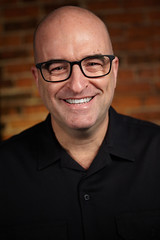 About the Interviewer
About the Interviewer
Greg Bennick (www.gregbennick.com) is a keynote speaker and long time coin collector with a focus on major mint error coins. Have ideas for other interviewees? Contact him anytime on the web or via instagram @minterrors.
To watch the complete video, see:
Tom Caldwell Interview
(https://nnp.wustl.edu/library/book/633370)
To read the complete transcript, see:
Tom Caldwell Interview (Transcript)
(https://nnp.wustl.edu/library/book/633369)
WORLD BANKNOTE AUCTIONS: 2023 REVIEW
World Banknote Auctions President Dennis Hengeveld published this year-end review in a note to customers this week. -Editor
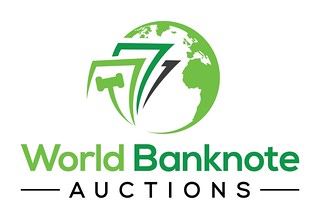 With 2023 coming to an end it is time for a brief look back on the past year and more importantly, a look forward to 2024 and beyond. Here at World Banknote Auctions we look back on a fantastic year, with tens of thousands of different lots offered in our auctions, and an overall sell-through rate of well in excess of 90% and many record-setting sales. We expanded more into US Currency and were able to offer a number of fantastic collections, including parts 1 and 2 of the Navy Commander Collection of National Banknotes and the Louisiana Bayou Collection of High Denomination notes. On the world side we offered the Isabella Chang Fong and Ian Marshall Collection of Jamaica, the catalog of which will no doubt become an important reference work on the banknotes of that country.
With 2023 coming to an end it is time for a brief look back on the past year and more importantly, a look forward to 2024 and beyond. Here at World Banknote Auctions we look back on a fantastic year, with tens of thousands of different lots offered in our auctions, and an overall sell-through rate of well in excess of 90% and many record-setting sales. We expanded more into US Currency and were able to offer a number of fantastic collections, including parts 1 and 2 of the Navy Commander Collection of National Banknotes and the Louisiana Bayou Collection of High Denomination notes. On the world side we offered the Isabella Chang Fong and Ian Marshall Collection of Jamaica, the catalog of which will no doubt become an important reference work on the banknotes of that country.
If there is one keyword that comes to mind when discussing the paper money market in 2023 it would be, in my opinion, maturing
. With the Covid-era now behind us (which saw a sudden and dramatic increase in demand for collectibles as a whole) it seems like the past four years has seen a dramatic swing in demand for paper money. New collectors have entered the market, and new registrations on our website have been steady in the past year, indicating a continued interest in paper money as collectibles. The crazy increase in prices that we have seen, however, has slowed down and a correction is evident in some areas, particularly for relatively common notes in better grades. Rarities continue to be in demand, and certain countries outperform others (the recent uptick in demand for notes of Persia and Iran as the prime example), but collectors are realizing that paying top dollar for every single note is no longer necessary, as another one is likely to come along. This is not necessarily a bad thing, and as a whole, prices are still higher than they were before 2020, especially for notes in better grades with fully original paper (something that is becoming more and more important).
World Banknote Auctions was recently named one of the top 100 Most Influential Companies by Coin World, something of which me and the entire team is extremely proud. Looking ahead to 2024, we have a couple of exciting things planned for the new year. We are continuing to implement changes to the website to provide a better experience. Soon, you will be able to purchase banknote collecting supplies in our online store, to be followed by direct sales of select better US and World Currency. We are currently updating our backend system and hope to rollout a new system in the next few months that will provide a better experience for both consignors and buyers. World Banknote Auctions has always focused on its detailed listings, high-quality catalogs and buyer-friendly policies, which include a low 15% buyer's premium for online sales and flat-rate shipping. On the consignment side, we continue to offer no seller's commission on any consignments, along with no other fees that are often found elsewhere, such as listing fees, catalog fees or imaging fees. We also continue to offer dedicated catalogs for advanced collections.
Besides our regular US and World Currency sales we have a couple of special sales already planned for 2024. In the first quarter we will offer selections from the Howard Daniel research collection of South-East Asia. Howard Daniel was one of the eminent researchers of the (paper) money of that area and published several important catalogs on the region. In late 2024 we will offer the first part of the Eric Agnew collection of California Financial History. Focused on National Banknotes of California, this is the most complete and advanced collection of the Golden State ever brought to the market and is sure to become a classic and important catalog once published.
This leaves me with wishing all collectors all the best for 2024, happy collecting, and don't hesitate to reach out with any questions, comments and concerns.
Howard was a good friend and great guy all around. We miss him dearly. We'll look forward to the catalog and sale. -Editor
To visit the WBNA website, see:
https://www.worldbanknoteauctions.com/
NUMISMATIC NUGGETS: DECEMBER 31, 2023
Here's a selection of interesting or unusual items I came across in the marketplace this week. Tell us what you think of some of these. -Editor
1853 J-151 Cent Pattern
Scarce R.6 pattern, only 32-40 minted. Very attractive, undergraded example has nice eye appeal and claims to higher grade. Trades from 3-5k. CU = 4750. Only four finer. If you like scarcity and a cool design you will love this one. Net Priced. 7226 (FP) $4500
Odd-looking spacing and lettering on the reverse. Glad this one didn't make it past the pattern stage. Nice coin regardless. From the Harry Laibstain Rare Coins site. -Editor
To read the complete lot description, see:
1853 1C J-151 *** PCGS PR64
(http://hlrc.com/Inventory/CoinViewer?id=871246003&c=23)
1797 Great Britain Two Pence Doubling Error
Ken Spindler writes:
"I think this is a pretty neat coin (for sale on eBay right now, PCGS VG08)! See the lettering on the broad rims of 1797 GB "cartwheel" tuppence - both sides."
Yes, neat error. Bad images. -Editor
To read the complete lot description, see:
1797 Great Britain 2 Pence PCGS VG 8 Copper Coin Mint Error DOUBLE STRUCK !!!!
(https://www.ebay.com/itm/155598811023)
High School of Dundee Scotland Medal
A Scottish silver medal titled High School of Dundee Dott Memorial Medal for Dux in the Art Department, Awarded to Edward C. Scott, Session 1917-1918, maker George David Rattray. Approx. 2" diameter
A very nice school medal. -Editor
To read the complete lot description, see:
Lot 1231: A Scottish silver medal titled High School of Dundee Dott Memorial Medal for Dux in the Art Departme
(https://www.invaluable.com/auction-lot/A-Scottish-silver-medal-titled-High-School-of-Dun-1231-c-AC74B3F82A)
Jewish-American Hall of Fame Medals
Barbara Streisand, Isaac Mayer Wise, Ruth Bader Ginsburg, Hedy Lamarr, Gertrude Berg, Leopold Karpeles, Dara Torres, Robert Rosenthal, Sgt Barney Ross, Rabbi Jacob Frankel, ? Miller, Morris Berg, Lillian Wald, Milton Berl. Some had drawstring holders.
A great opportunity to acquire a collection of these super medals. -Editor
To read the complete lot description, see:
14 JEWISH-AMERICAN BRONZE HALL OF FAME MEDALS
(https://bid.alexcooper.com/lots/view/1-8HN679/14-jewish-american-bronze-hall-of-fame-medals)
British North Borneo Company One Dollar
BRITISH NORTH BORNEO: George VI, 1936-1952, 1 dollar banknote, 7.1.1940, Pick-29, British North Borneo Company issue, small piece missing from left margin, Good, ex Joe Sedillot Collection.
From the upcoming Stephen Album Rare Coins auction. -Editor
To read the complete lot description, see:
BRITISH NORTH BORNEO: George VI, 1936-1952, 1 dollar banknote, 7.1.1940, Good
(https://www.sarc.auction/BRITISH-NORTH-BORNEO-George-VI-1936-1952-1-dollar-banknote-7-1-1940-Good_i51275828)
DATES ON ANCIENT COINS
Mike Markowitz published a nice CoinWeek article about dates on ancient coins. Here's an excerpt - see the complete article online. -Editor
DATES ARE SO universal on modern coins that it may come as a shock to learn that most ancient coins provide no indication of when they were minted. The Common Era
(or AD
, Anno Domini) dating system used in our world to designate years did not come into general use on European coins until the 16th century. A wide variety of dating systems were used by different cultures in the ancient world to keep track of years, and in some cases, these appear on coins.
Zankle
Silver Tetradrachm, Zancle 491/490 BCE 17.072 g, 23.5 mm. Asyut hoard. Chisel cut. Image: American Numismatic Society.
The earliest coins to bear a year date were a brief experiment – lasting just six years – by Greek refugees from the Aegean island of Samos who fled the Persian occupation of their homeland to settle at Zankle (today Messina, Sicily) in 494 BCE. On coins they struck, they dated their arrival as Year One
, indicated by a prominent letter A (alpha, the Greek numeral for 1). Coins are known for Years 1, 2, 4, 5 and 6, but no coin of Year 3 has ever turned up. These silver tetradrachms show the head of a lion on the obverse, and the prow of a ship on the reverse. One of the few published examples of this series that I found is dated Year Four (with delta, ?, the fourth letter of the Greek alphabet) in the collection of the American Numismatic Society (ANS) in New York. The coin, from the famous Asyut Hoard found in Egypt in 1969, has a deep chisel cut that nearly broke it in half.
Samos
Samos. Circa 453/2-440/39 BC. Silver Tetradrachm (24mm, 13.09 g,). SNG Copenhagen 1681. Classical Numismatic Group. Auction 117. 19 May 2021. Lot: 224. Realized: $8,000
Back on Samos a few decades later, this experiment was repeated. From 454 to 440 BCE, silver tetradrachms of Samos were dated with a sequence of Greek alphabetic numerals. The date letter appears on the reverse, below the chin of a bull. A rare example with a date from Year 5 brought $8,000 USD in a 2021 U.S. auction. The experiment was abandoned in 439 when Samos was defeated in a short war by Athens.
To read the complete article, see:
Dates on Ancient Coins
(https://coinweek.com/how-to-read-dates-on-ancient-coins/)
1965 SILVER ROOSEVELT DIME FIND
The December 2023 issue of ErrorScope from the Combined Organizations of Numismatic Error Collectors of America (CONECA) included a article by Greg Bennick about a man's chance discovery of a rare error. With permission, we're republishing it here. Thanks to Greg and ErrorScope editor Allan Anderson. -Editor
NUMISMINUTIA: Errors are Out There: An Incredible Find!
By Greg Bennick
I recently had an amazing experience at a local coin show near Seattle where I learned of another collector's incredible find, and I wanted to share it with readers as inspiration to keep up the search!
There are still coins out there to find! I live in Seattle, and around this part of the country there are a handful of coin shows across the Pacific Northwest, though most are smaller than the major shows I often attend around the rest of the country. I tend to make a huge mistake and long for the big shows, when every single time I attend a smaller local show or a mid-sized regional show in this area, I have an incredible time and find something cool, or have a conversation with someone, which makes it entirely worth it to have gone. The moral, right off the bat: always support smaller coin shows! Sure, it is exhilarating to walk into a room with a thousand tables, but there's magic to be found at local shows too and you can build a great network of new friends by attending them.
I had an experience at a very small local show a month or so ago and wanted to share about it. I was at the Kent WA coin show. It is a very small show, with maybe fifteen dealers. I went through the show looking for errors and was done
in about twenty minutes…but then I decided to sit and look for weird things that I just happen to like beyond error coins. It is good to diversify, so I collect counterstamps and also local Seattle area historical tokens with errors on them (of course!).
I was sitting at the table of a prominent local token dealer looking through his massive number of token books. Just tables full of them. I had looked through a thousand or more tokens, when suddenly next to me sat down a man who looked like he was directly out of Sons of Anarchy. He had a jean jacket with patches on along with a bandana and had a look like a biker. I was immediately interested. I love when people of all different backgrounds and varieties are at coin shows. I kept looking through the tokens. And I heard this man strike up a conversation with the dealer. He said, I found something recently and I have a question about it.
I figured it was a token, and admittedly I don't know a ton about tokens in general so I just kept searching through the books.
The token dealer asked what the coin was, and the man said, Well, it's something that I don't know much about, but I had it slabbed by ANACS.
The dealer asked to see it and the man handed her the coin. I kept looking through the tokens, but overheard the dealer say, I think it's on a wrong planchet.
Well now, of course, my attention was immediately piqued! I turned and looked while the man said, Yeah. That's what someone told me.
The two contemplated what the coin was, if it was real, and if the find was significant. I asked if I could see the coin, explaining that I had overheard that it was on the wrong planchet and that I'm addicted to errors. The man handed me the coin and I couldn't believe what I was looking at.
He had an 1965 Roosevelt dime, clearly struck on a 90% silver planchet and slabbed as such from ANACS. It was a transitional wrong planchet error. The coin had been cleaned, with hairlines from someone likely wiping it a bit to see why it wasn't quite right
. One could tell quite easily though from looking with the naked eye that the tone was right for silver around the periphery. ANACS had definitely slabbed it correctly. I asked the man if he collected errors and he said that he didn't really. I asked him where he bought this coin and he said, he hadn't bought it.
He said, I found it in a Coinstar machine.
I couldn't believe it. I asked him if that was really true, and he said it was. He said he always goes through Coinstar machines looking for odds and ends and seeing if anyone left any change behind. This time someone had. He found the coin interesting as it looked unusual and he brought it home. Being a somewhat novice but experienced enough collector, he decided to send it off to have it authenticated because he wanted to know more about it and had decided on ANACS because they were among the least expensive third-party grading services.
As far as we could tell, we think somebody passed that coin through the Coinstar machine. For whatever reason, likely because it was silver, it was rejected by the machine. Maybe they passed it through again, and it was rejected again so they decided to just leave it thinking it was fake.
The man said that he had gotten a few offers on the coin from the few people he had shown it to, and said that he had been offered several hundred dollars. I said he should add a zero to that number and up the game considerably to the next person who makes him an offer. And I congratulated him on what was an amazing find. I immediately let him know that I was with the press so to speak and that I write for Errorscope and asked to take photos.
The moral of the story is that there are still coins out there to find whether from the bank, roll hunting, or even in change. It is impossible to think that all the coins yet to be found have already been found. We just have to keep up the search. This coin was a perfect example.
At the CONECA table this summer in Pittsburgh, we had a man and his daughter come up to the table with an entire book of coins they had pulled from roll hunting. They said they went through many thousands of dollars of coins each month. The book contained mostly damaged coins, but there were many errors too, some substantial! Like a split die piece, some major off centers, cuds, and other coins.
If you happen to find any fantastic coins like the dime my new friend found, while you're going through your change, in a roll, or organically in the world, please let me know! This wrong planchet find was hugely inspiring and whatever you find might be an inspiration for other collectors as well!
Interested in error and variety coins? Join CONECA!
https://conecaonline.org/
1983 COPPER LINCOLN CENT
A much more subtle wrong-planchet error is described in this Stack's Bowers article by Senior Numismatist Greg Cohen. -Editor
In the age of click bait articles about finding rare pennies
in your pocket or in your change jar, our offices field countless calls daily from folks who think they have discovered their fortune this way. Most times, unfortunately, their coins are not rarities, but are worth just what is stamped into the design. This blog though is about the discovery of one of the finest known wrong planchet, transitional cent errors of 1983.
Copper cents were struck from the earliest days of the mint in 1793 until August 1982, when due to the rising cost of copper, the change was made to a copper plated zinc planchet. The old copper planchets have a weight of 3.1 grams, while the new Zilincolns
as they are sometimes nicknamed, weigh significantly less at 2.5 grams. For this item (and the few others like it) to have been created, a bin that had been used to store copper planchets before the switch, was reused in 1983. A copper planchet, stuck in the bin, was shaken loose and fell into the hopper, along with thousands of the copper coated zinc blanks. This planchet made it into the coining press, was struck, went into a bag, and was released from the Mint to the Federal Reserve system and then sent to a bank for circulation.
This coin, graded MS-64 RB by NGC, must have been pulled from circulation early on. The color is an appealing mix of mint orange-red that blends with soft gray-brown tones. The strike is somewhat soft in places, as the dies were set for the lighter and softer copper-plated zinc planchets. No marks of consequence can be found anywhere; we note, for the sake of full disclosure, a few unobtrusive carbon flecks.
This is a very rare and important modern issue that, like the 1943 copper cent, belongs in an advanced set of Lincoln cents.
To read the complete article, see:
A MODERN CENT RARITY: THE 1983 CENT STRUCK ON A COPPER PLANCHET
(https://stacksbowers.com/a-modern-cent-rarity-the-1983-cent-struck-on-a-copper-planchet/)
STACK'S BOWERS OFFERS TRIAL OF THE PYX COINS
Through a marketing arrangement with The Royal Mint, Stack's Bowers Galleries will be selling coins evaluated at the 2023 Trial of the Pyx. Here's the press release. -Editor
on Behalf of The Royal Mint
Stacks Bowers Galleries is honored to once again partner with The Royal Mint of the United Kingdom for an auction sale of historic British numismatics. Presented in February 2024 will be a special auction of coins that have been tested and evaluated as part of the annual Trial of the Pyx, an ancient and rigorous evaluation ceremony with origins that stretch back over seven centuries. This is the first time these Trial of the Pyx test coins will be presented in a public auction, and it is sure to draw attention from collectors and investors around the world.
The Trial of the Pyx is conducted annually by The Royal Mint to ensure the accuracy and integrity of the nation's coinage. Dating to 1282, it is one of the oldest judicial ceremonies in England. During the trial, a selected panel of expert assayers from the Goldsmiths' Company, an independent organization, examines a sample of coins produced by The Royal Mint the previous year. The coins are tested for weight, diameter, composition, and design, verifying their compliance with legal standards set by the Coinage Act. The findings are reported to the Royal Remembrancer, who presides over the trial on behalf of the Crown. The trial concludes with an announcement of the verdict, confirming the quality and accuracy of the coinage.
Learn more about the time-honored tradition of the Trial of the Pyx with our seven minute mini-documentary. This exclusive feature offers an unparalleled glimpse behind the scenes of this historic event. Through captivating interviews with key figures and rare footage, we explore the intricate details of this meticulous process that is a cornerstone of monetary integrity and heritage.
This special auction by Stack's Bowers Galleries will feature an impressive selection of gold, silver, and platinum coins tested in the 2023 Trial of the Pyx. Comprising a wide range of categories, they include numismatic classics such as the Sovereign and Britannia series, as well as celebrations of modern pop-culture icons including James Bond, Harry Potter, and The Rolling Stones. This selection is particularly noteworthy for spanning the numismatic legacies of two monarchs – Queen Elizabeth II and King Charles III – as well as many coins struck to celebrate Her Late Majesty the Queen's Platinum Jubilee. Highlights in this offering include examples of the Gold 5 Ounce 2022 Britannia Proof coin, the Gold 5 Ounce 2022 Queen Elizabeth II Memorial Gold Proof coin, the Platinum £ 5 2022 Queen Elizabeth II Proof Piedfort coin, the Gold 2 Ounce 2022 Rolling Stones Proof coin and the 2022 Harry Potter Proof coins.
This auction event will certainly have global appeal on multiple fronts,
stated Stack's Bowers Galleries President
Brian Kendrella. The subject matter featured on the coins runs the gamut from pop culture to the British Monarchy
to actual British coinage, and we expect the prices realized will include some very affordable collector's items
alongside extremely valuable rarities. Our entire team is excited about bringing this historically important offering to
market.
The auction will feature both individual items and multi-coin lots, offering collectors a variety of options to purchase these exciting test pieces. The coins will be encapsulated by leading grading service Numismatic Guaranty Company (NGC) and will feature custom labels recognizing their historic significance. Every coin also bears distinct evaluation marks associated with the Trial of the Pyx, making each a truly unique treasure.
Lucy Mackenzie, Director of Collector Services at The Royal Mint said: We are delighted to continue our
partnership with Stacks Bowers Galleries with this next auction of Trial of the Pyx coins. The Trial of the Pyx is one
of the United Kingdom's longest-established judicial ceremonies, ensuring the quality and accuracy of our coinage
since 1282. The coins included in this auction are those tested in the 2023 Trial of the Pyx, and provide an
opportunity for collectors to secure a unique piece of its history.
This offering represents a union of America's most prestigious and accomplished numismatic auctioneer with the United Kingdom's oldest continually operating company and the second oldest mint in the world. The Royal Mint was founded over 1,100 years ago, responsible for the coinage of England and, thereafter, the United Kingdom, and has since grown to become the world's leading export mint, respected for the exceptional quality of their collectible and bullion coinage. Stack's Bowers Galleries was founded in New York City in 1933 and has built a reputation as America's leading auctioneer of rare coins over the past century, handling some of the greatest rarities and most valuable collections ever sold. Together, these historic firms are delighted to present these test pieces from the 2023 Trial of the Pyx to collectors.
This joint-effort between Stack's Bowers Galleries and The Royal Mint comes on the heels of a similar partnership between the two organizations in August 2023, where a special auction sale of Royal Succession Sovereign and Britannia coins realized more than $5.1 million in total prices, including a Gold 1 Ounce 2023 Britannia that sold for $50,000.
Stack's Bowers Galleries is honored to have been selected by The Royal Mint to auction these special Trial of the Pyx test coins and is excited to present them to the collecting community in February 2024. For more information about these historic Trial of the Pyx coins or to register for bidding in the auction, please contact Stack's Bowers Galleries at Info@StacksBowers.com or 800-566-2580.
Why not? Great idea. There's nothing special about the coins themselves, but having been part of the annual rite is interesting and of value to collectors, and the slabbing documents this. -Editor
To watch the video, see:
Historic Trial of the Pyx Coins Presented by Stack's Bowers Galleries on Behalf of The Royal Mint
(https://www.youtube.com/watch?v=O43USRA-d_w)
2024 ROYAL MINT COMMEMORATIVE COINS
David Pickup passed along this article about new commemorative coin designs from the Royal Mint. He writes, "I think the RNLI design is the most striking." -Editor
Commemorative coins celebrating Sir Winston Churchill, Buckingham Palace and the RNLI lifeboat charity have been unveiled by the Royal Mint.
The 2024 annual set also includes a 200th anniversary of the National Gallery £ 2 coin and a Team GB and Paralympics GB 50p coin.
The Royal National Lifeboat Institution (RNLI) will have its 200th anniversary in 2024, and the Royal Mint produced an official UK 50p to mark this. Created by John Bergdahl, the design displays the RNLI flag surrounded by a life ring.
The Buckingham Palace £ 5 coin was designed by artist Henry Gray and features the architecture of Buckingham Palace front and centre of the coin.
The £ 2 coin struck to mark the 150th anniversary of the birth of Sir Winston Churchill depicts a portrait of him as a young man in 1895, in the uniform of the 4th Queen's Own Hussars.
The edge inscription: "Pave the way for peace and freedom," is taken from a remark he made in late 1953, while serving his second term as prime minister. The design was created by Natasha Seaward, a graphic designer at the Royal Mint.
Created by designer, engraver and printmaker Edwina Ellis, the design appearing on the UK £ 2 features the National Gallery building at the centre of the coin.
The Royal Mint said it produced an official UK 50p to celebrate and wish Team GB and Paralympics GB athletes the best of luck at the Paris 2024 Games.
Designed by Charis Tsevis, the 50p depicts two athletes representing the Olympic and Paralympic Games.
I'm more impressed with the Olympics design. Very clever! What do readers think of these? -Editor
To read the complete article, see:
Coins with Churchill and the RNLI revealed by Royal Mint
(https://www.bbc.com/news/uk-england-london-67834919)
THE BOOK BAZARRE
18TH CENTURY GERMAN CYPHER WHEEL
Secret codes make fun puzzles, and here's a numismatic connection. A medallic 18th-century German cypher wheel is described in this article by Stack's Bowers Senior Numismatist and Cataloger Jeremy Bostwick. -Editor
Keeping sensitive information secure and data encrypted are omnipresent aspects in our increasingly technological lives, with two-factor authentication even more commonplace. While the level of tech behind such measures has advanced greatly recently, the reasoning behind them has been just as important no matter the period in human history. The need for relaying information in a secure, private manner has taken many forms—with one such method being the substitution cypher. In this form of encryption, one letter stands in for another, with the recipient of the protected data able to decipher its true meaning only by using a code or a key. Lot 52090 in our January 2024 Auction (in conjunction with the New York International Numismatic Convention [NYINC]) served this exact role.
Emanating from the Sydney F. Martin Collection, and previously from the extensive and celebrated John J. Ford Collection, this bi-level engraved silver cypher wheel features elegant engraving on each side. Additionally, one side displays names that indicate various functions within the hierarchy of the Holy Roman Empire. These are led by the Emperor and Empress (Imperator and Imperatrix), the Imperial Vicar, the various Electors (Archbishops of Mainz, Trier, and Cologne; King of Bohemia, Count Palatine of the Rhine, Duke of Saxony, Margrave of Brandenburg, and Duke of Brunswick-Luneburg), neighboring rulers such as the Kings of Sweden, Denmark, and Poland, and other higher-ranking officials in the German-specific power structure of the Empire.
Meanwhile, the other side presents a movable outer ring with the 24 letters of the Roman alphabet in order (J and V being omitted), a fixed inner ring with those same letters in a randomized order, and another movable interior ring that, when rotated, reveals a third letter in the cut-out area above the engraved ruins. The sum of this creates a level-two substitution encryption, and a code that would realistically only be deduced by the bearer of a decoder. Furthermore, the codes that begin and end each individual mentioned on the one side, such as the 1 and 15 for the Emperor, may indicate that any number between the two may stand in as a code for that particular official.
Given its mention of the Duke of Brunswick-Luneburg, this piece must be dated between the elevation of the duchy to electorate status (1692) and its takeover by Napoleon (1807). Additionally, mentioning the Imperatrix may further narrow the chronology to the reign of Maria Theresa and a more important role being given to a female within the normally male-dominated Holy Roman Empire. As such, this piece may more specifically be dated to 1740-1780. Beautifully crafted and attractively toned, it represents an extremely interesting piece of paranumismatica, made more appealing by its association with two phenomenal collections.
To read the complete lot description, see:
GERMANY. Holy Roman Empire. Bi-Level Engraved Silver Cypher Wheel, ND (ca. 18th Century).
(https://auctions.stacksbowers.com/lots/view/3-17B20A/germany-holy-roman-empire-bi-level-engraved-silver-cypher-wheel-nd-ca-18th-century)
To read the complete article, see:
ENGRAVED SILVER CYPHER WHEEL FROM THE MARTIN & FORD COLLECTIONS
(https://stacksbowers.com/engraved-silver-cypher-wheel-from-the-martin-ford-collections/)
SOUTHERN STATES BANKNOTE ALBUM
The Cincinnati & Hamilton County Public Library has posted images of a scrapbook of paper money and bonds, mostly circa 1861-1864. Found via News & Notes from the Society of Paper Money Collectors (Volume IX, Number 28, December 26, 2023). -Editor
Title
Bank notes and shinplasters of the southern states
Date
1837-1864
Description
An album of 155 mounted specimens of paper money and bonds, chiefly 1861-1864, with a few earlier examples. Includes paper money from most of the southern states, as well as southern banks and companies such as County of Augusta, County of Fluvanna, Farmers Savings Bank, Parish of St. Landry, City of Petersburg, Va., and others. Some are mounted over a cut out area so the back can be viewed. Also includes money of the Confederate states, a $1,000 Confederate bond certificate, and three stock certificates from mining companies in the Nevada territory.
Great example of an old-time collection of notes drawn from circulation, plus some uncut sheets. Here are several notes that caught my eye. -Editor
To see the complete album, see:
Bank notes and shinplasters of the southern states
(https://digital.cincinnatilibrary.org/digital/collection/p16998coll24/id/29452)
BARTLETT, TEXAS BANK RENOVATION
In the "Honey, I bought a bank!" department, here's the story of a converted bank building in Bartlett, Texas. -Editor
Jennifer Tucker was exploring the downtown streets of Bartlett, a quaint town nestled in southeast Texas, when she stumbled upon an abandoned bank in 2019.
"It was dilapidated, and nobody had opened the front door in many, many years," Tucker, 49, told Business Insider. "It was in pretty bad shape."
Tucker owns Amazing Realty, a real-estate brokerage based in Austin, and is passionate about historic preservation. The bank building — a relic of Bartlett's heyday in the early 20th century — was a shell of its former self.
Tucker recalled walking up to the bank's front windows and peeking inside, where the phrase "Bartlett Natl. Bank" was carved on the tile floor.
"At that moment, I just knew I had to have this building," Tucker said.
Now Bartlett National Bank has three bedrooms and two bathrooms on two floors and is available for rent at $248 a night on Airbnb.
A plaque on the building's brick exterior touches on the history of Bartlett National Bank, which opened in June 1904 with $25,000. It remained operational until 1931, when it closed for a federal holiday amid the Great Depression and did not reopen for several decades.
Bartlett National Bank made a brief three-year return in the 1990s but was shuttered again because it lacked drive-up teller windows, according to the plaque. Although the bank survived an ill-fated attempted robbery in the 1960s and appeared in the 1998 film "Newton Boys," starring Matthew McConaughey, it remained relatively quiet until Tucker stepped in.
To read the complete article, see:
A 119-year-old bank sat abandoned in a tiny Texas town for decades. Now it's a 3-bedroom home with the original vaults and a teller station — take a look.
(https://www.businessinsider.com/photos-119-year-old-texas-bank-renovated-3-bedroom-home-2023-12)
PUZZLE PURISTS DECAMP TO A CASTLE
While totally non-numismatic, collectors of all stripes will appreciate this New York Times piece about the couple who bought a castle to hold their massive collection of puzzles. -Editor
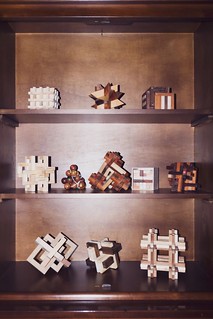 Meet the Millers, George and Roxanne, proprietors of the world's largest collection of mechanical puzzles: physical objects that a puzzler holds and manipulates while seeking a solution. In total, the Miller collection — an accumulation of collections, and collections of collections — amounts to more than 80,000 puzzles. It comprises some five thousand Rubik's Cubes, including a 2-by-2-by-2 rendering of Darth Vader's head. And there are more than 7,000 wooden burr puzzles, such as the interlocking, polyhedral creations by Stewart Coffin, a Massachusetts puzzle maker; they evoke a hybrid of a pine cone and a snowflake and are Mr. Miller's favorites. Mrs. Miller is fond of their 140 brass, bronze and gold puzzle sculptures by the Spanish artist Miguel Berrocal; Goliath, a male torso in 79 pieces, is
Meet the Millers, George and Roxanne, proprietors of the world's largest collection of mechanical puzzles: physical objects that a puzzler holds and manipulates while seeking a solution. In total, the Miller collection — an accumulation of collections, and collections of collections — amounts to more than 80,000 puzzles. It comprises some five thousand Rubik's Cubes, including a 2-by-2-by-2 rendering of Darth Vader's head. And there are more than 7,000 wooden burr puzzles, such as the interlocking, polyhedral creations by Stewart Coffin, a Massachusetts puzzle maker; they evoke a hybrid of a pine cone and a snowflake and are Mr. Miller's favorites. Mrs. Miller is fond of their 140 brass, bronze and gold puzzle sculptures by the Spanish artist Miguel Berrocal; Goliath, a male torso in 79 pieces, is a puzzle that all puzzlers lust after,
she said.
Until recently, the Miller collection resided at Puzzle Palace in Boca Raton, Fla., filling their mansion and a museum (a smaller house) next door. Puzzles occupied even the bathrooms. Then last year, on a whim, the Millers bought a 15th-century, 52-room castle in Panicale, a hamlet in central Italy. They packed their puzzle collection into five 40-foot shipping containers and, for their own transit, booked a cruise from Miami to Rome.
Before sailing away in April, the Millers went on a two-month road trip — a last hurrah,
Mr. Miller called it — visiting puzzler friends from coast to coast. Along the way they accumulated more puzzles.
The Millers met at the International Puzzle Party in 2010, married in 2018 (after parallel divorces) and melded their collections. She came to the marriage with about 20,000 puzzles; he had a couple thousand.
Fast forward to 2021: The Millers acquired the 40,000-puzzle Hordern-Dalgety collection in Britain (previously two collections by Edward Hordern and James Dalgety; Mr. Hordern had amalgamated the collections of Edith Constance Jardine Senior and Eileen Scott, among others). You can see why we had to buy a castle,
Mr. Miller told the computer scientist Donald Knuth during the couple's visit to his house in Stanford, Calif.
Over the years, Dr. Knuth and Mr. Miller have collaborated on a handful of puzzles, taking a difficult mathematical problem and solving it and then working out a mechanical analog,
as Mr. Miller described the process. Their most successful collaboration was Cubigami 7: The goal is to fold 18 interlocking plastic squares into seven arrangements of four cubes, or tetracubes.
Mr. Miller had casually mentioned the idea at a puzzle party. I stayed up all night working on it,
Dr. Knuth said.
As they chatted, he opened a cupboard, jampacked with puzzles. I keep them all hidden because I don't know how to put them back together again,
Dr. Knuth said.
To read the complete article, see:
Need a Home for 80,000 Puzzles? Try an Italian Castle.
(https://www.nytimes.com/2023/12/29/science/puzzles-mechanical-miller.html)
LOOSE CHANGE: DECEMBER 31, 2023
Here are some additional items in the media this week that may be of interest. -Editor
Numismatic News published a review by Mike Thorne of the 6th Edition of Volume II of the Cherrypickers' Guide. Here's an excerpt - see the complete article online. -Editor
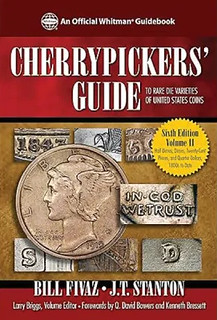 Well, it's finally here: the 6th edition of Volume II of the Cherrypickers' Guide. But is it what cherrypickers have been waiting for? Or is it something else, something that presages a third volume?
Well, it's finally here: the 6th edition of Volume II of the Cherrypickers' Guide. But is it what cherrypickers have been waiting for? Or is it something else, something that presages a third volume?
Unfortunately, I think it's the latter. Don't misunderstand me: I don't mean to imply that there's anything wrong with the new book. I think it does a great job for the material covered, which is half dimes through quarter dollars. But it really doesn't replace the 5th edition volume II, which covered half dimes through quarter dollars and also half dollars, silver dollars, gold coins, commemoratives, and bullion.
Because the new edition doesn't replace its predecessor, the 5th edition volume II is selling for big bucks on Amazon (used at $78.97 and up) and eBay ($125). With that said, what will you find in the new edition?
To read the complete article, see:
Basics and Beyond: Review of Latest ‘Cherrypickers' Guide'
(https://www.numismaticnews.net/collecting-101/basics-and-beyond-review-of-latest-cherrypickers-guide)
To read earlier E-Sylum articles, see:
CHERRYPICKERS' GUIDE, 6TH EDITION, VOLUME II
(https://www.coinbooks.org/v26/esylum_v26n23a06.html)
CHERRYPICKERS' GUIDE SECOND PRINT RUN
(https://www.coinbooks.org/v26/esylum_v26n37a08.html)
A Dave Bowers article discusses his interest in wheatback cents, from a time when many relative rarities in the series were still available in circulation. -Editor
When I was a kid in 1952 in Forty Fort, Pennsylvania, I visited Robert Rusbar, the town tax collector, to see his collection of rocks and minerals—a prime interest of mine at the time. He showed me an album with a 1909 penny with an S below the date and the letters V.D.B. on the reverse, saying he had paid $10 for it at the coin department boutique at Gimbel's department store in New York City. I found this to be amazing and immediately set about finding some in change. That did not happen. The rest is history, as they say.
I was on a train traveling from Chicago to Phoenix in December 1958 when I read a newspaper account that the familiar wheat-stalk reverse design of the Lincoln cent would be changed to depict the Lincoln Memorial. There was no advance notice of this in the numismatic press.
In due course the Memorial Reverse cents reached circulation. The numismatic response was modest at best, with Don Taxay stating the motif looked like a trolley car.
To read the complete article, see:
Bowers on Collecting: harvesting Wheat pennies 1909-1958
(https://mintnewsblog.com/bowers-on-collecting-harvesting-wheat-pennies-1909-1958/)
Everybody loves a story about a nice lost hoard of collectibles. This Washington Post piece discusses a valuable video game time capsule. -Editor
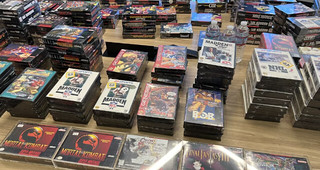 Mark placed more than 300 sealed games into boxes and moved them to an Omaha storage unit. As 23 years passed, Mark lost track of what the games were worth and decided he would pass them on to his nieces and nephews.
Mark placed more than 300 sealed games into boxes and moved them to an Omaha storage unit. As 23 years passed, Mark lost track of what the games were worth and decided he would pass them on to his nieces and nephews.
But in 2021, Mark's older brother, Tim, found the vintage games in the warehouse and was curious about their worth. The '90s-era games, including Chrono Trigger
and Mortal Kombat,
were still in near-perfect condition. He said he sought out guidance at an Omaha video game store, where the employees were shocked at what Tim had brought them.
The Odorisios eventually had the video games appraised, and about 170 of them were found to be rare and in good condition. Gameroom, the store where Tim took the games in 2021, is helping the Odorisios sell the collection, which was recently posted online.
Mark said he's hoping to sell the games for nearly $1 million — a figure much higher than he had expected when he stored them.
To read the complete article, see:
He closed a video game shop decades ago. His games could sell for $1M.
(https://www.washingtonpost.com/nation/2023/12/19/nebraska-rare-vintage-video-games-sale/)
Nick Graver passed along these links from his friend Marcel Safier, presenting an overview of how Australia is adopting their new King Charles III coins. Thanks. -Editor
To read the complete articles, see:
King Charles III now on Australian coins
(https://ministers.treasury.gov.au/ministers/andrew-leigh-2022/media-releases/king-charles-iii-now-australian-coins)
King Charles III Effigy - Frequently Asked Questions
(https://www.ramint.gov.au/news-media/news/king-charles-iii-effigy-frequently-asked-questions)
Last week John Regitko asked, "I wonder how many collectors have books in their library that they never read? I bet every one!" That seems to be a common lament of bibliophiles everywhere, as seen in this post by Ed Simon. Reminds me of the time I hosted several friends from work at my house. In giving a short tour I said, "Here are the records I don't have time to listen to, and over there are the books I don't have time to read..." -Editor
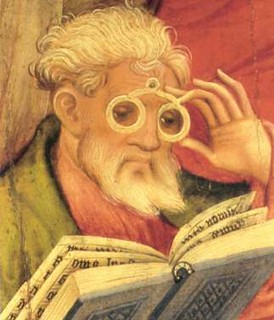 I'm haunted by the enormity of all of that which I'll never read. This need not be a fear related to those things that nobody can ever read, the missing works of Aeschylus and Euripides, the lost poems of Homer; or, those works that were to have been written but which the author neglected to pen, such as Milton's Arthurian epic. Nor am I even really referring to those titles which I'm expected to have read, but which I doubt I'll ever get around to flipping through (In Search of Lost Time, Anna Karenina, etc.), and to which my lack of guilt induces more guilt than it does the real thing. No, my anxiety is born from the physical, material, fleshy, thingness of the actual books on my shelves, and my night-stand, and stacked up on the floor of my car's backseat or wedged next to Trader Joe's bags and empty pop bottles in my trunk. Like any irredeemable bibliophile, my house is filled with more books than I could ever credibly hope to read before I die (even assuming a relatively long life, which I'm not).
I'm haunted by the enormity of all of that which I'll never read. This need not be a fear related to those things that nobody can ever read, the missing works of Aeschylus and Euripides, the lost poems of Homer; or, those works that were to have been written but which the author neglected to pen, such as Milton's Arthurian epic. Nor am I even really referring to those titles which I'm expected to have read, but which I doubt I'll ever get around to flipping through (In Search of Lost Time, Anna Karenina, etc.), and to which my lack of guilt induces more guilt than it does the real thing. No, my anxiety is born from the physical, material, fleshy, thingness of the actual books on my shelves, and my night-stand, and stacked up on the floor of my car's backseat or wedged next to Trader Joe's bags and empty pop bottles in my trunk. Like any irredeemable bibliophile, my house is filled with more books than I could ever credibly hope to read before I die (even assuming a relatively long life, which I'm not).
A strong and bitter book-sickness floods one's soul,
writes Nicholas Basbanes in A Gentle Madness: Bibliophiles, Bibliomanes, and the Eternal Passion for Books. How ignominious to be strapped to this ponderous mass of paper, print, and dead men's sentiments!
To read the complete article, see:
Ed Simon's Twelve Months Of Reading – 2023
(https://3quarksdaily.com/3quarksdaily/2023/12/ed-simons-twelve-months-of-reading-2023.html)
To read the earlier E-Sylum article, see:
MORE ON THE MONEY MUSEUM
(https://www.coinbooks.org/v26/esylum_v26n52a10.html)
THE TANGBUNIA BANK OF VANUATU
Much as I hate clickbait headlines, I couldn't resist "Inside The World's Weirdest Bank." From the India Times. Found via News & Notes from the Society of Paper Money Collectors (Volume IX, Number 27, December 19, 2023). -Editor
In whichever country you reside, the first thing that comes to mind when we hear the word 'banks,' is dealing with money through currency, right? Be it the country's domestic and/or foreign currency. But can you imagine a bank that does not deal with currencies?
Well, there indeed is an unusual bank that is said to be the world's weirdest one since it doesn't deal with the usual currencies. It is the Tangbunia Bank on Pentecost Island in the South Pacific nation of Vanuatu. It uses the native currency of boar tusks instead of Western-style money.
To provide a standard way of reckoning these varied forms of money, the bank uses its own currency: livatu or "tusk-money", a unit equal to the value of one fully-curved boar's tusk. The livatu can be exchanged with the vatu, Vanuatu's official currency.
Here's another fascinating fact. As per a conversation on social networking platform Reddit, the Tangbunia Bank uses a unique writing system known as Avoiuli, also devised by Chief Viraleo. It was designed over a 14-year period for the local Raga language and is based on designs found in traditional sand drawings.
When the South Pacific Republic of Vanuatu won its independence in 1980, the islanders' initial optimism for their future was short-lived. Their new nation may have gained political freedom, but economically it remained dependent on the outside world. With such a small economic base, any scheme requiring serious money - such as the much-needed rebuilding of dilapidated schools and roads - relied on the generosity of foreign donors.
Chief Viraleo solved these problems by establishing a 'traditional bank' at which spare pigs and pigs' tusks could be deposited - a literal piggy bank. These are then lent out at a profit, enabling the bank to pay back its savers with a hefty 15% rate of interest. The bank issues chequebooks and allows transfers between accounts, eliminating the need for pigs to be physically dragged from place to place whenever a transaction is made. Dyed mats and other traditional items of value can also be deposited.
For more information, see:
Tangbunia Bank
(https://en.wikipedia.org/wiki/Tangbunia_Bank)
Piggy banking
(http://www.andrewgray.com/pacific/piggybank.htm)
To read the complete article, see:
Inside The World's Weirdest Bank That Does Not Deal In Usual Currency
(https://www.indiatimes.com/worth/news/worlds-weirdest-bank-does-not-deal-in-usual-currency-623225.html)





